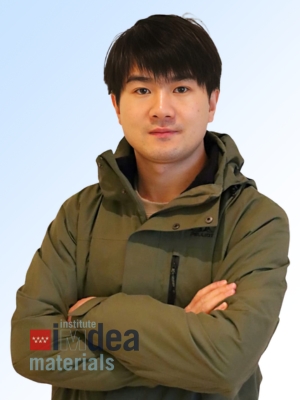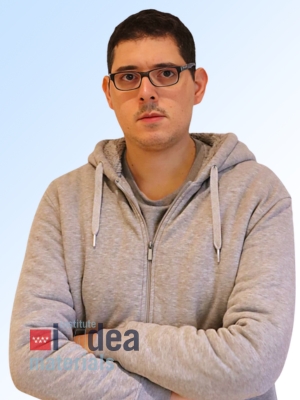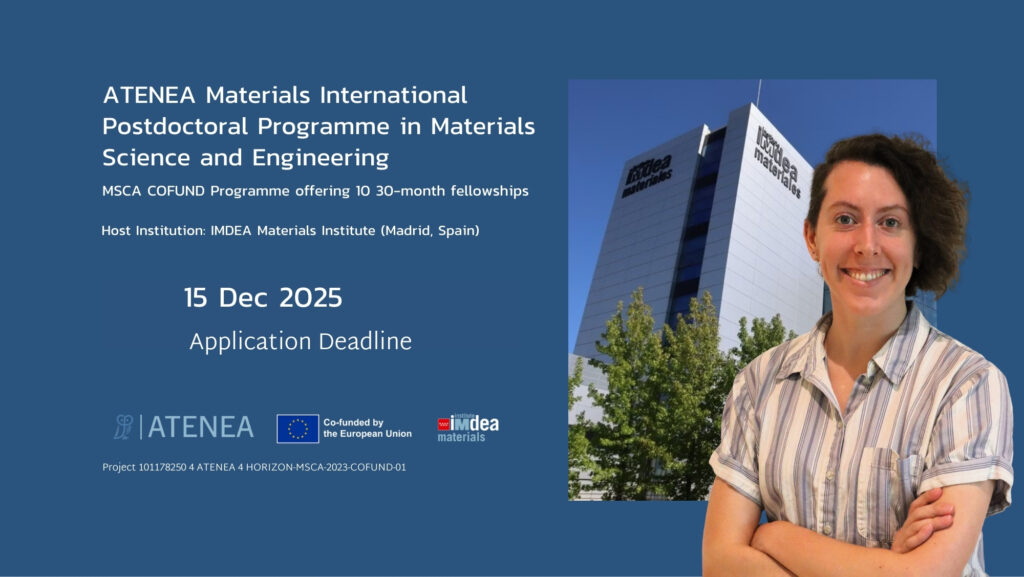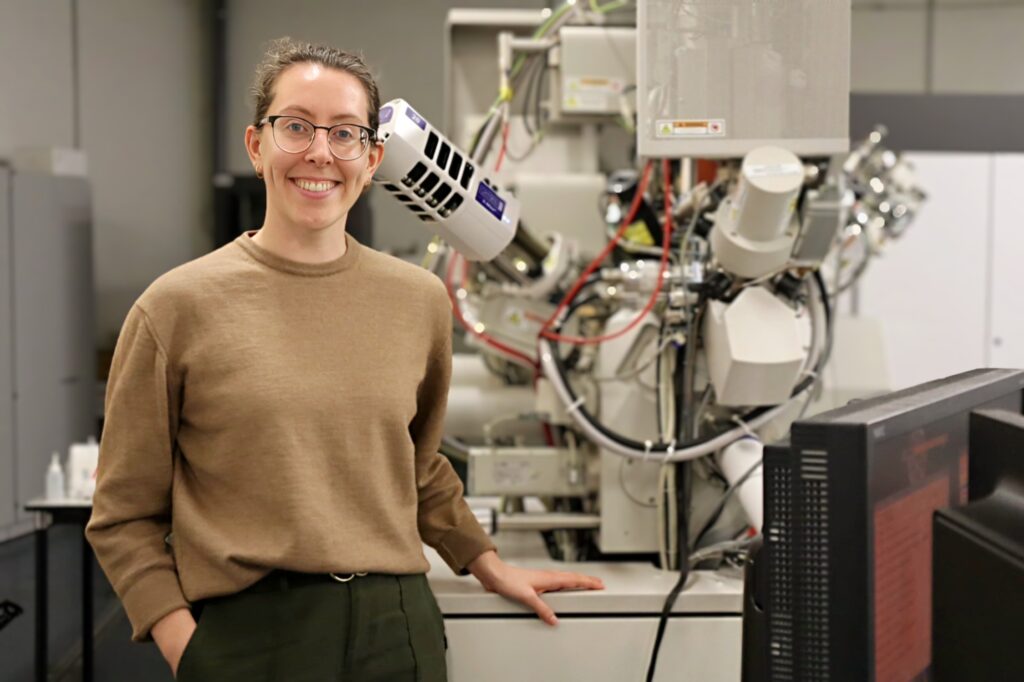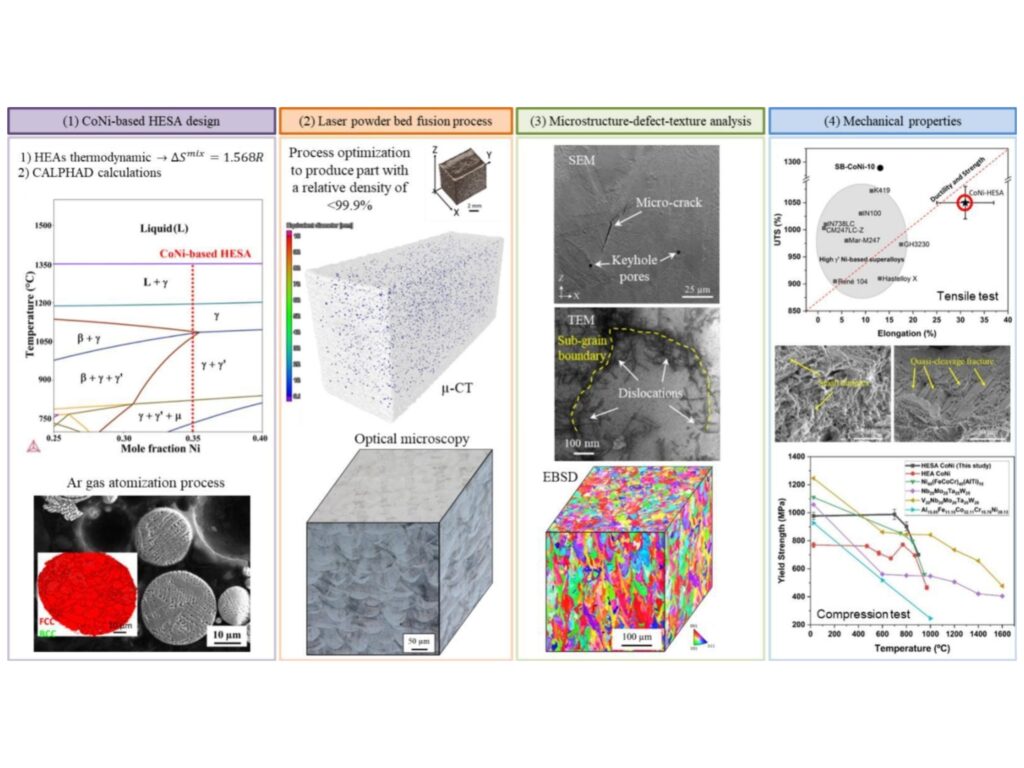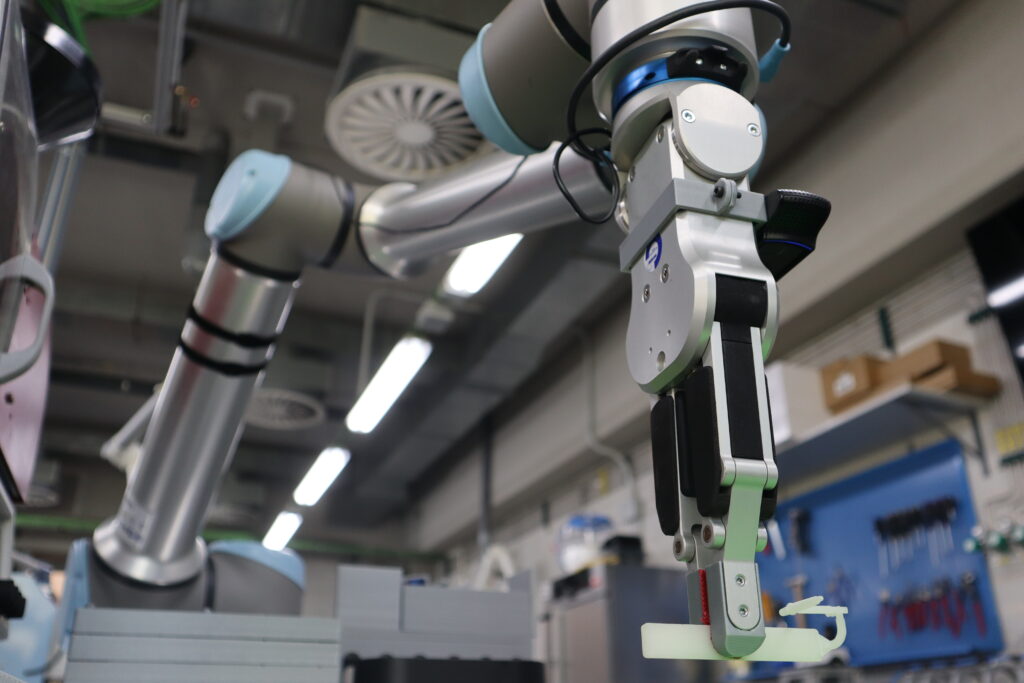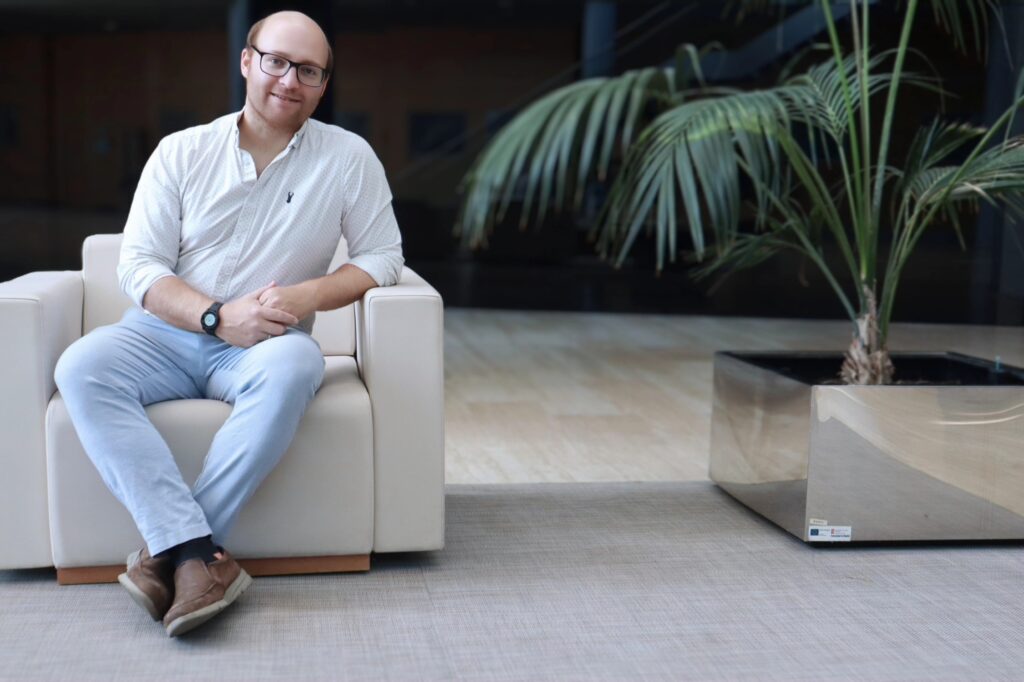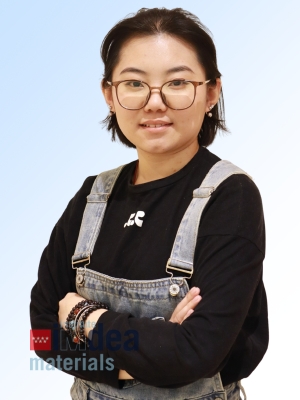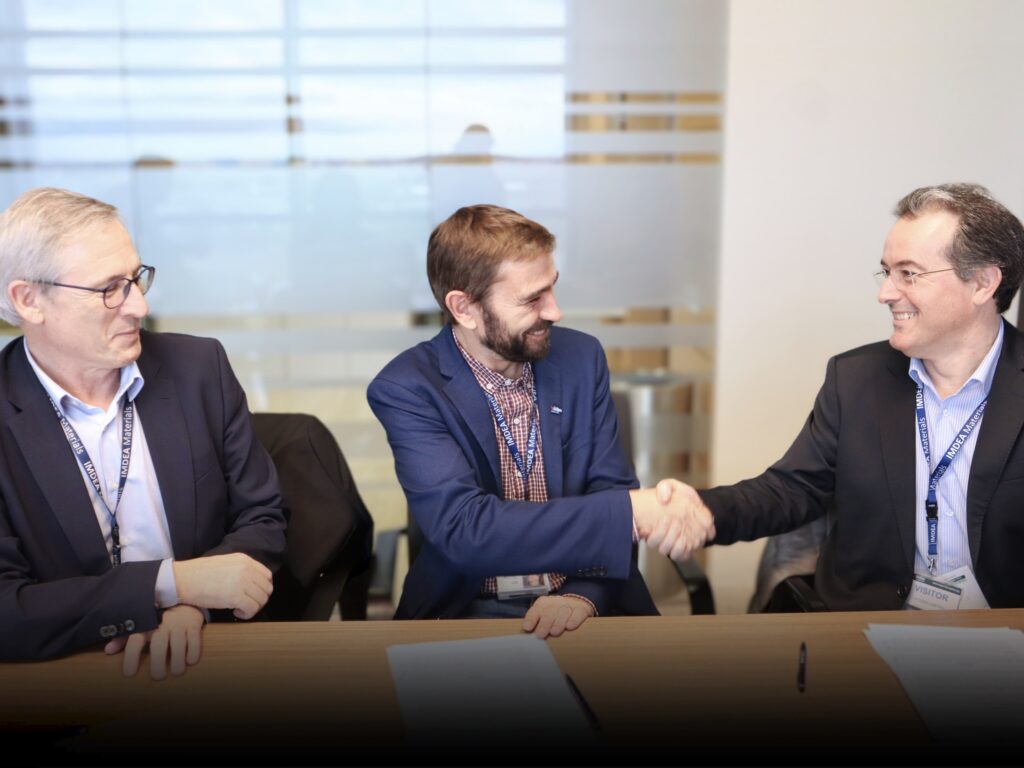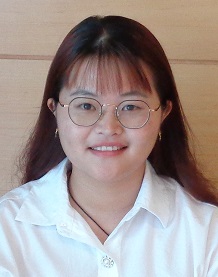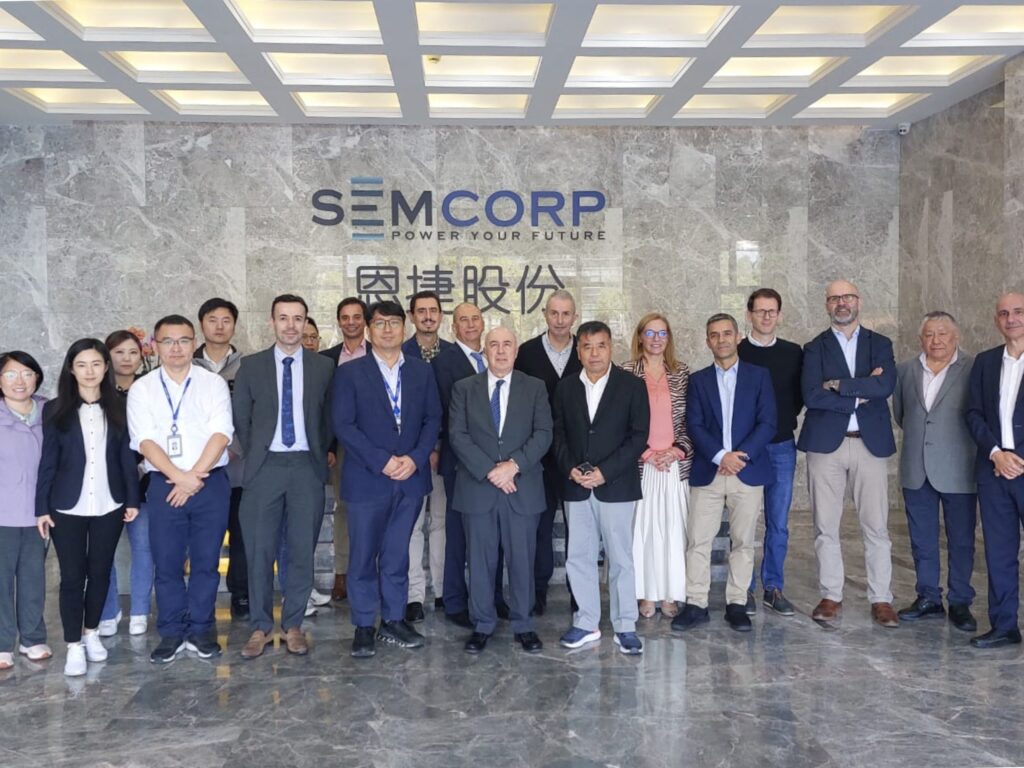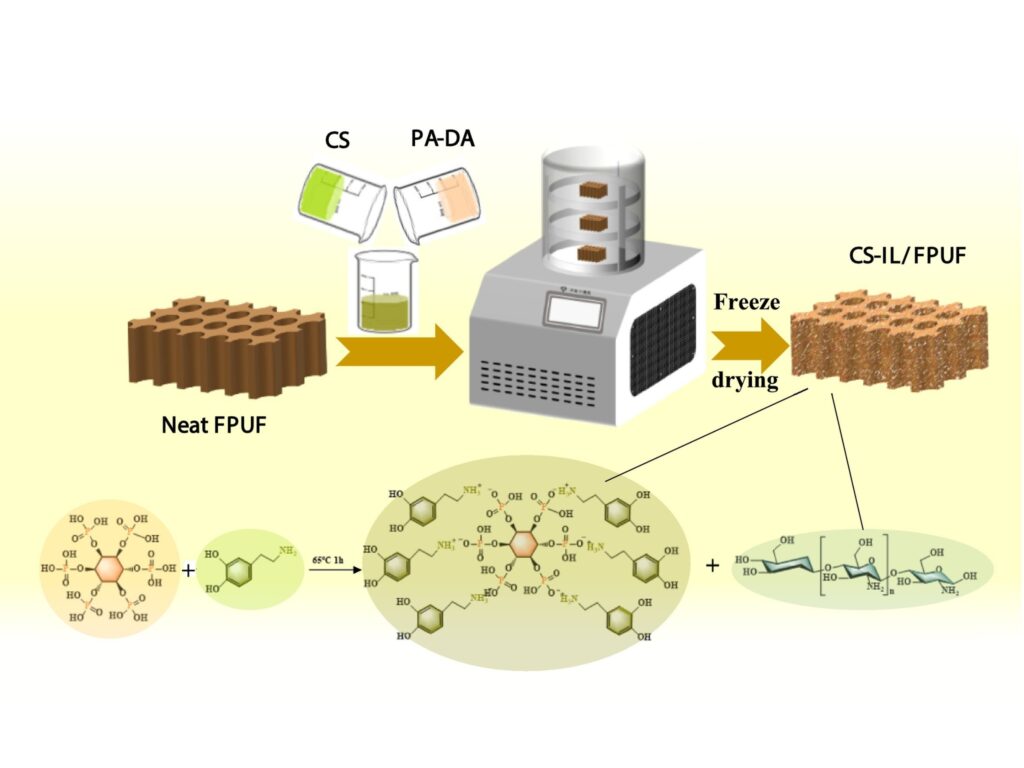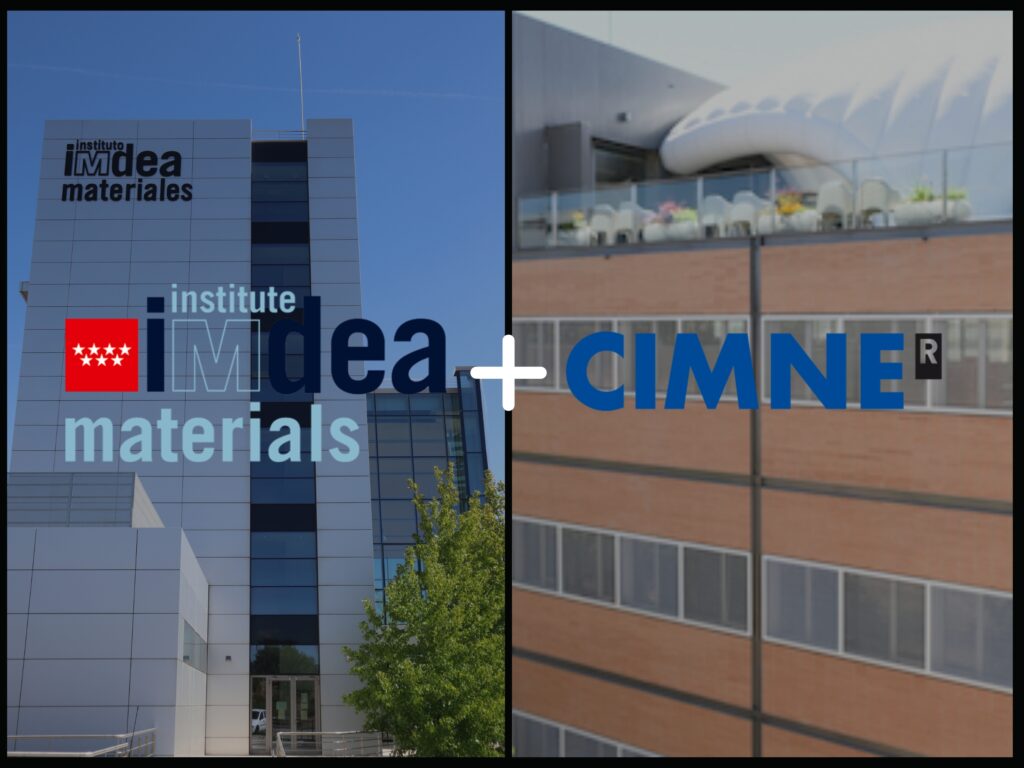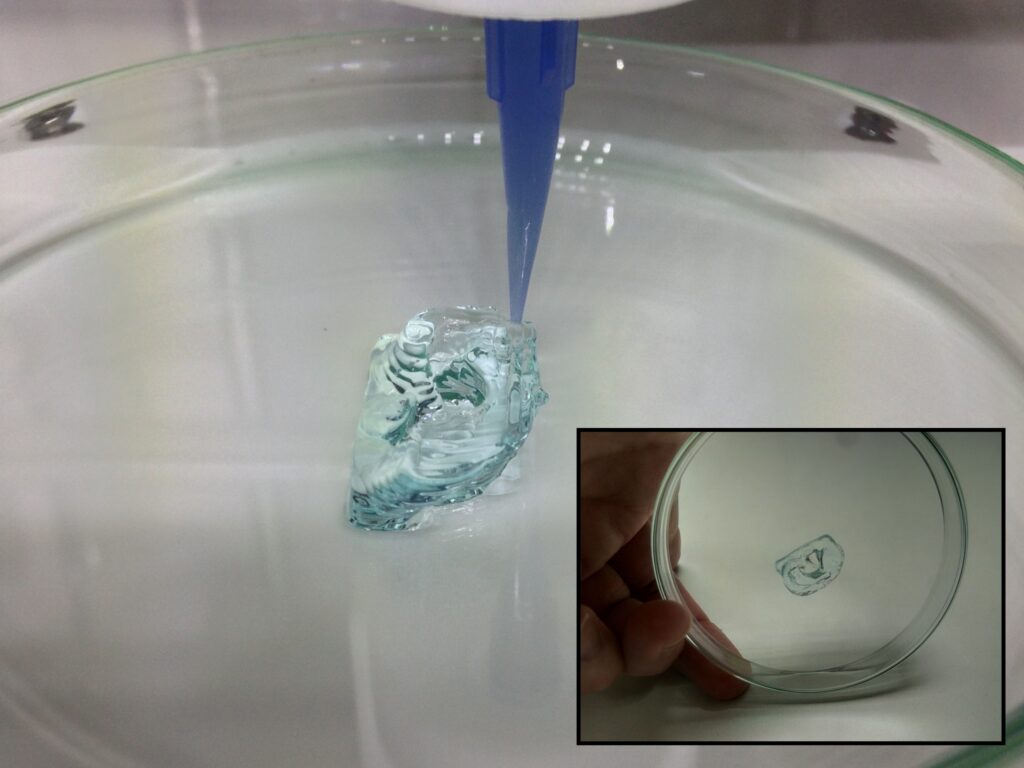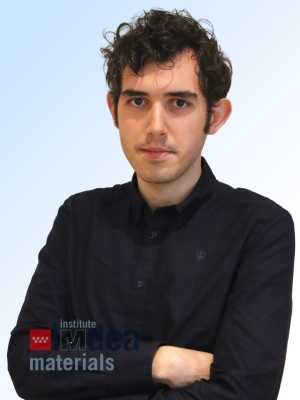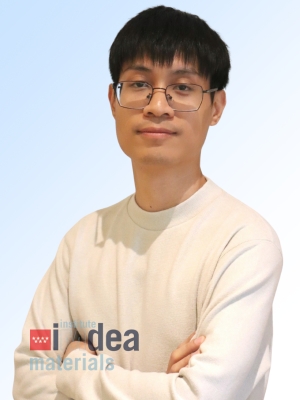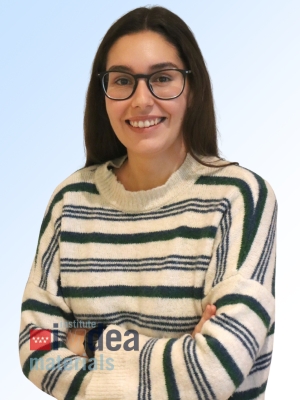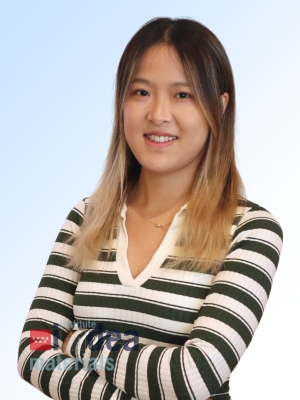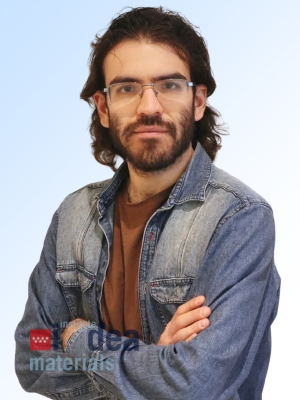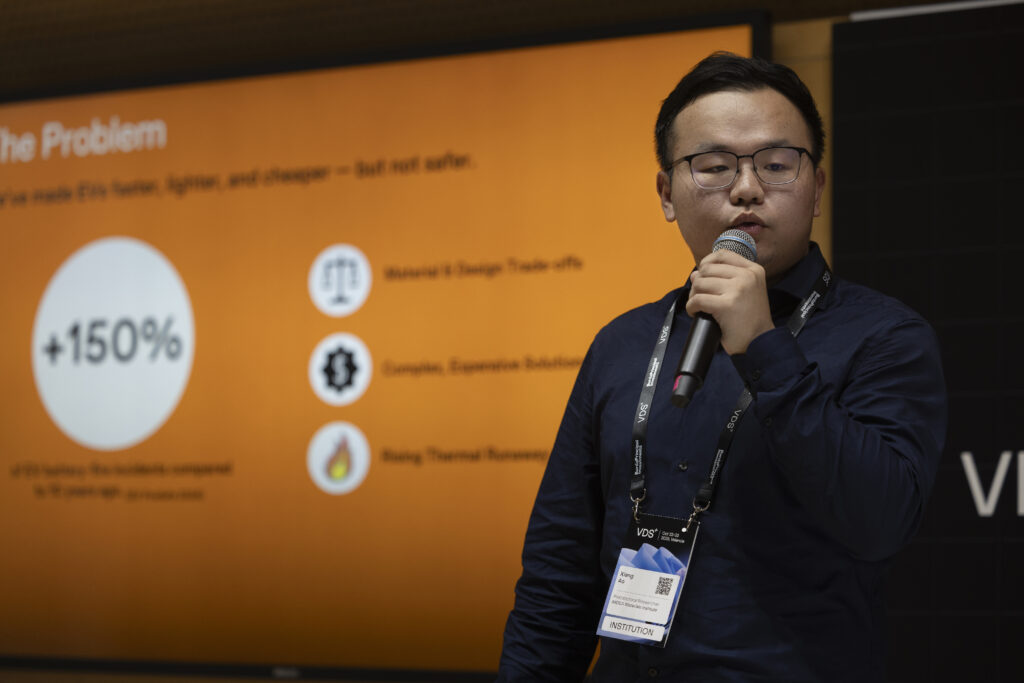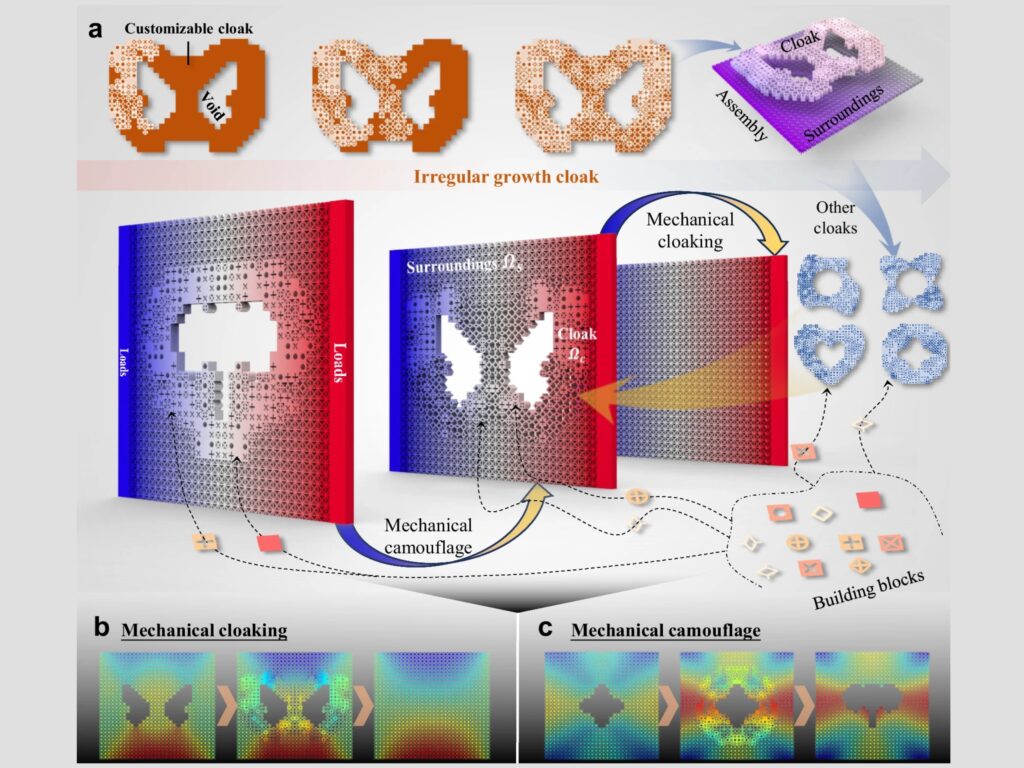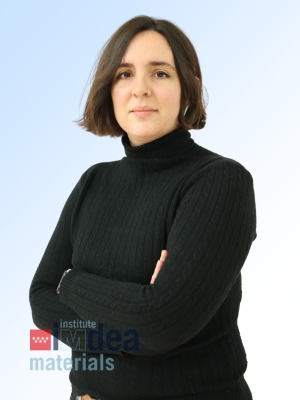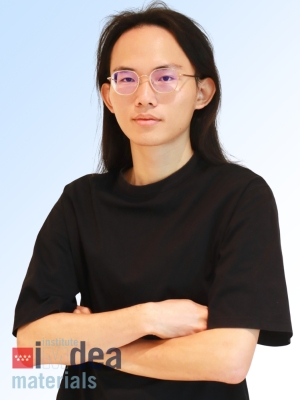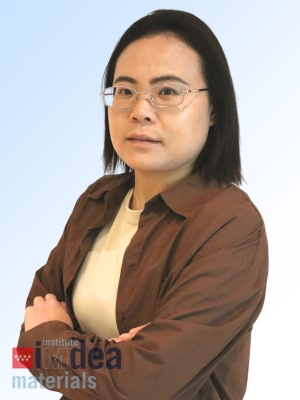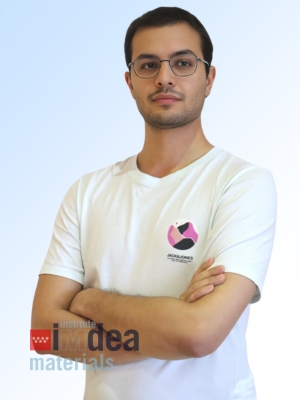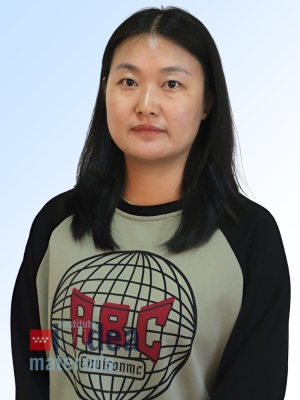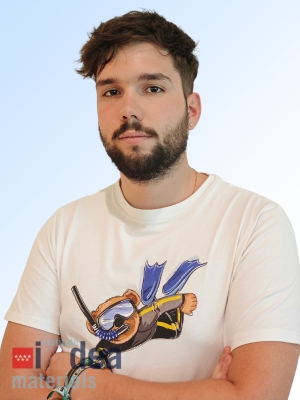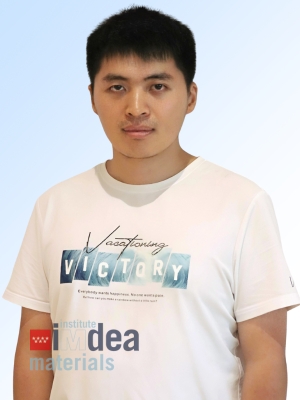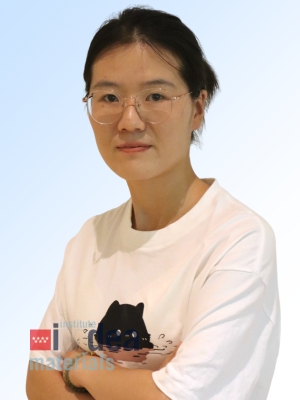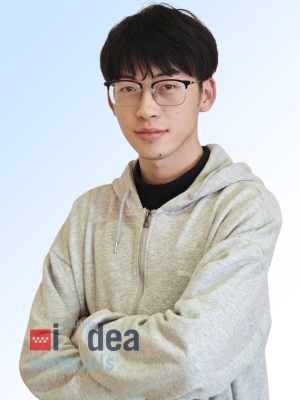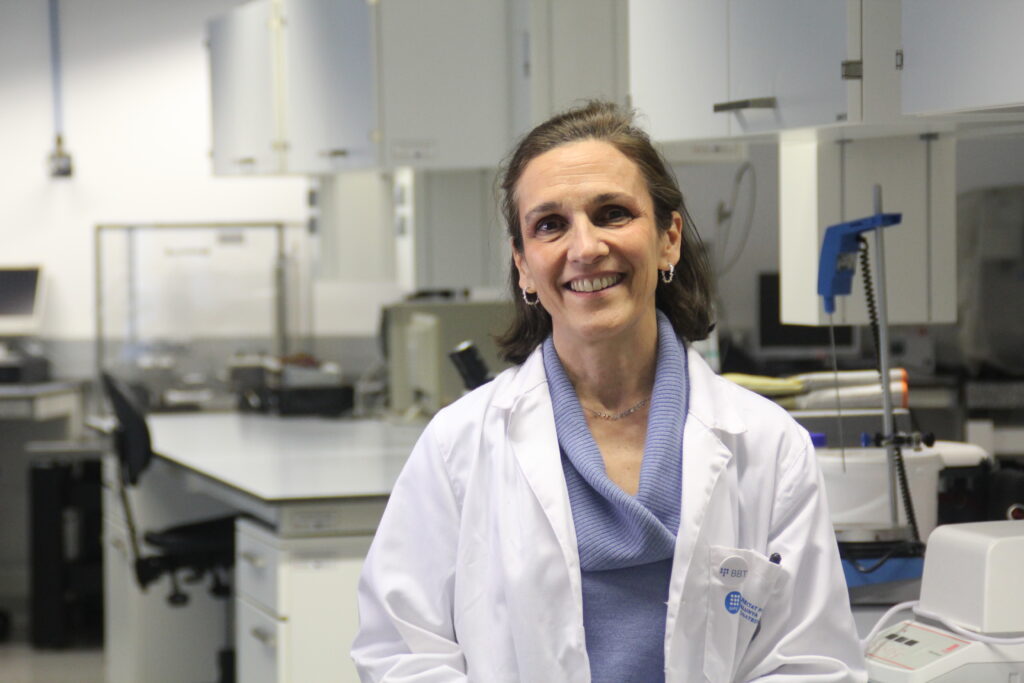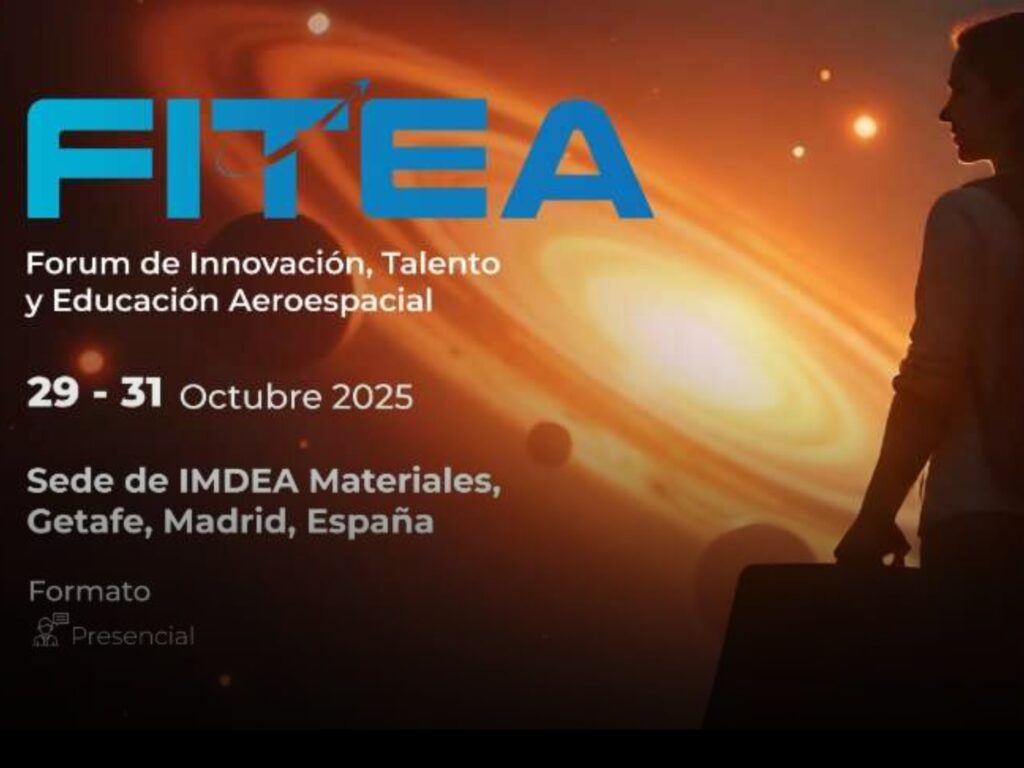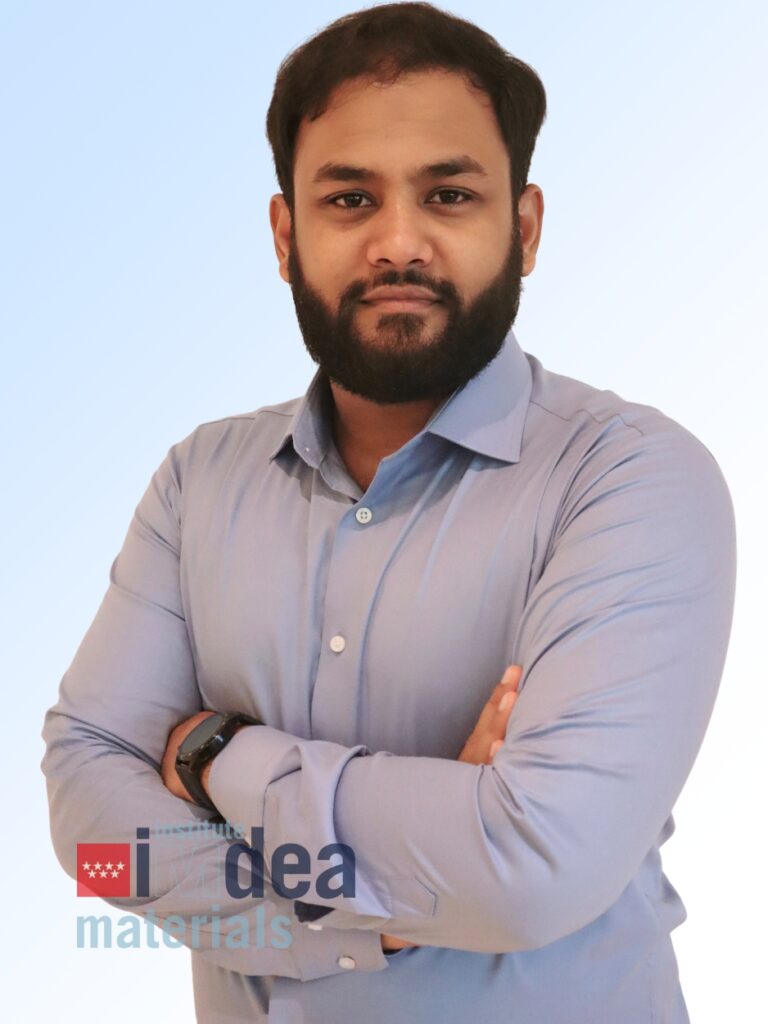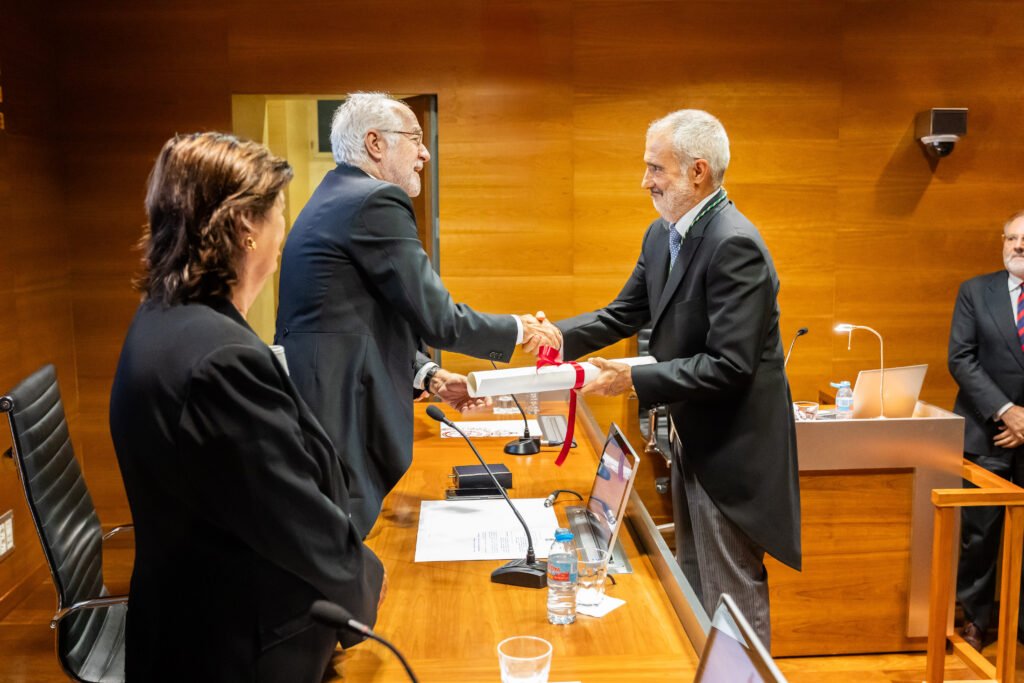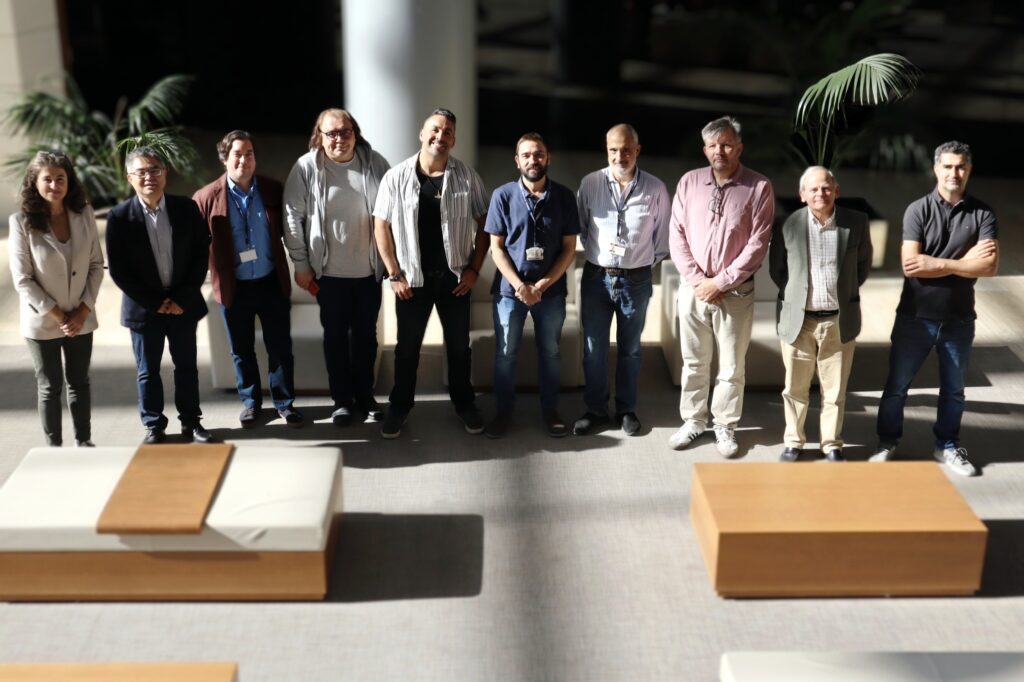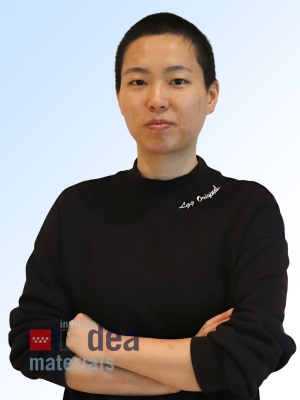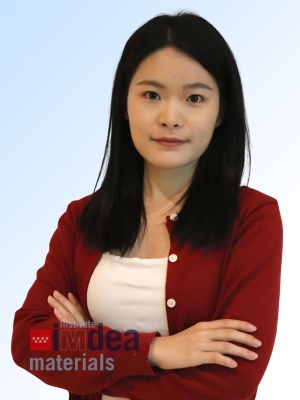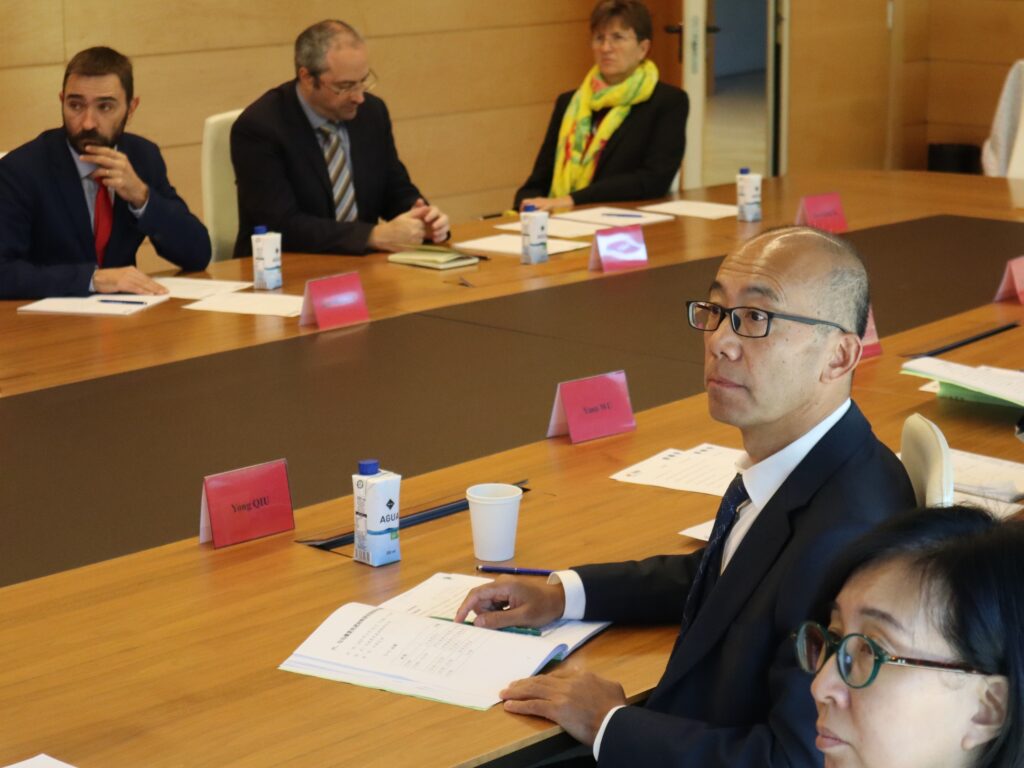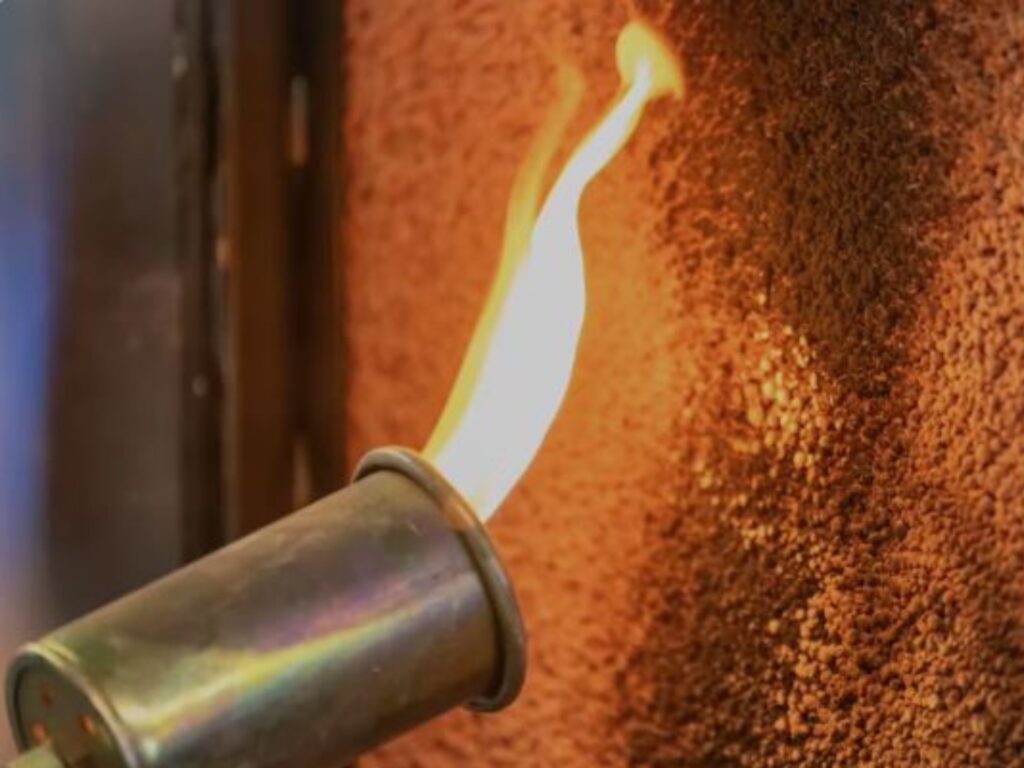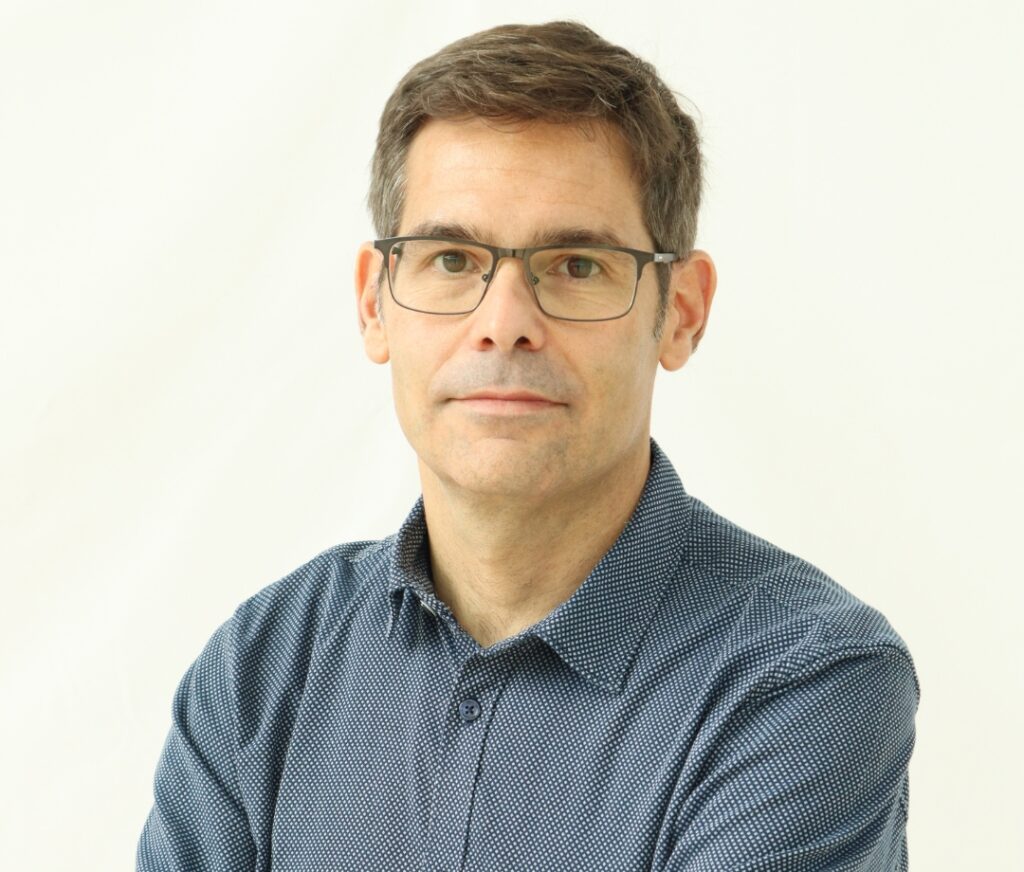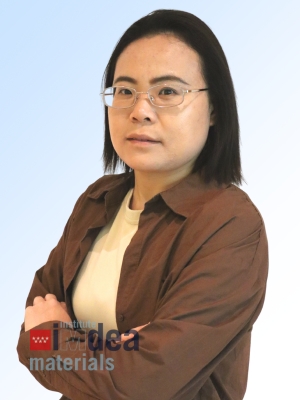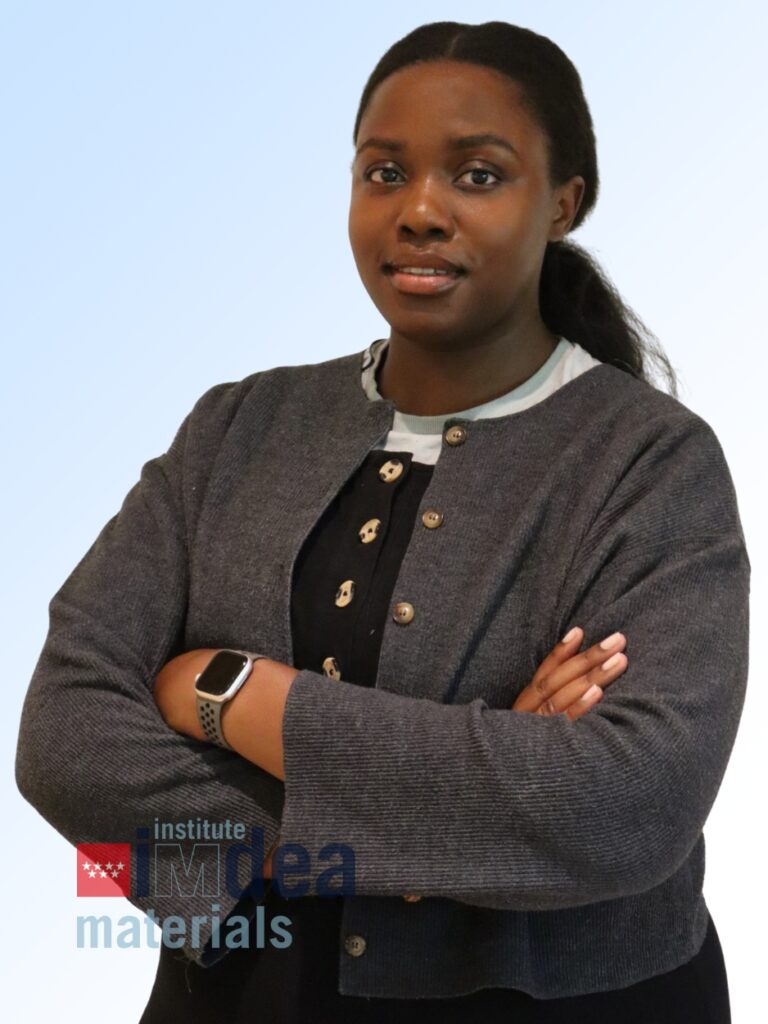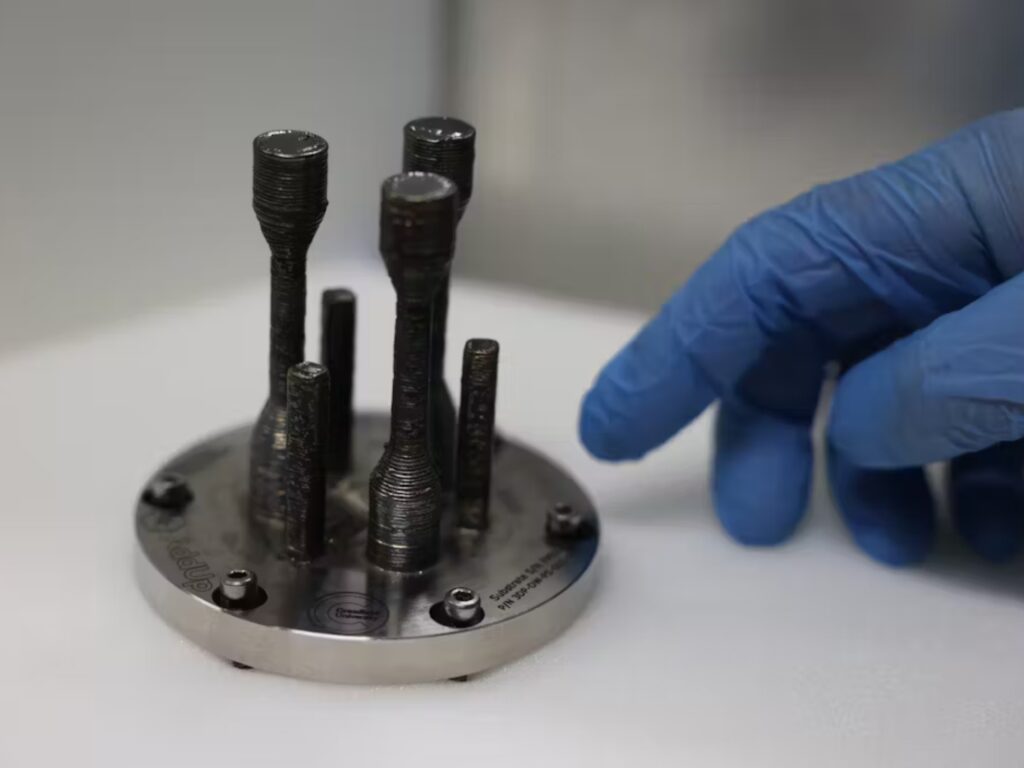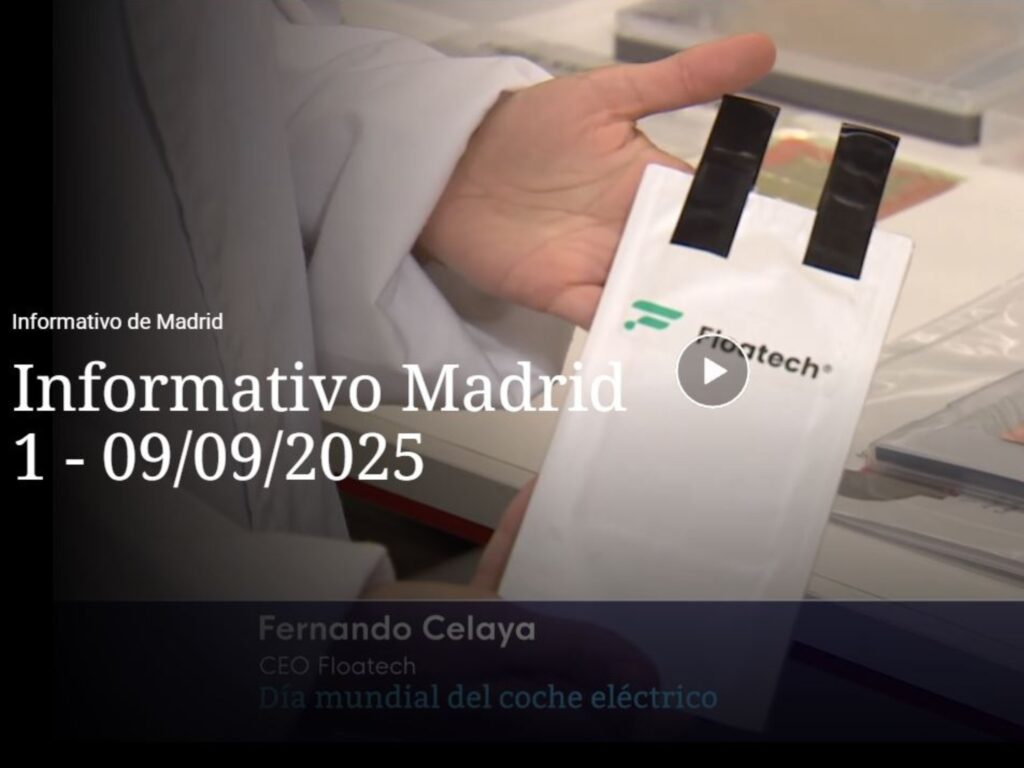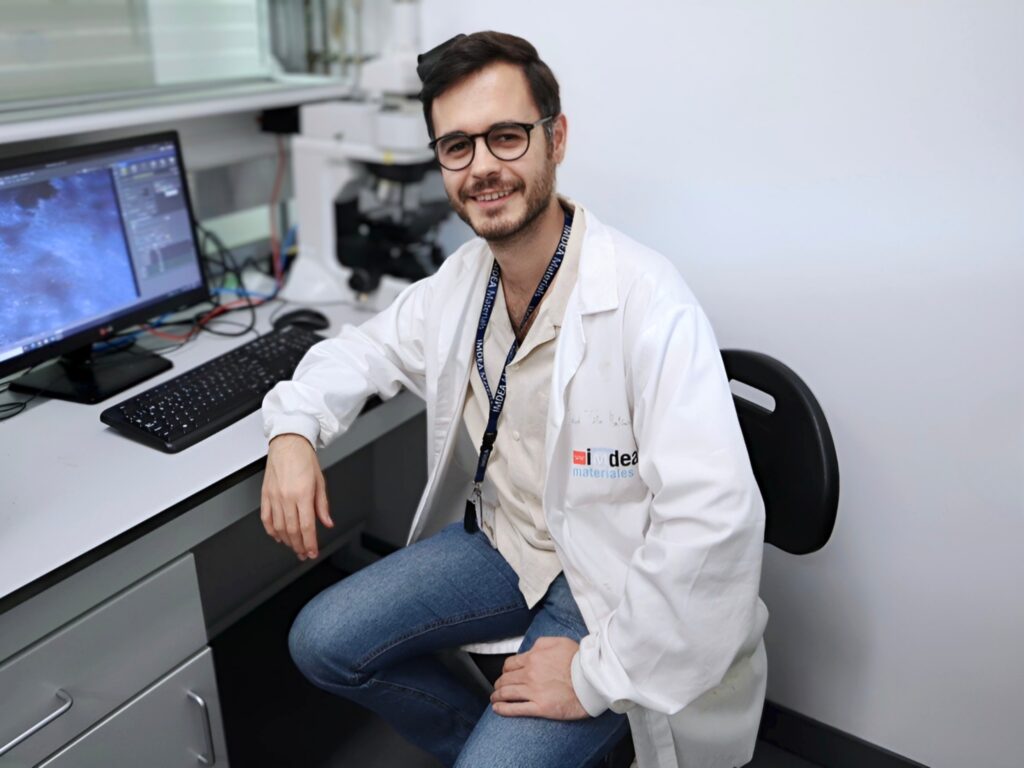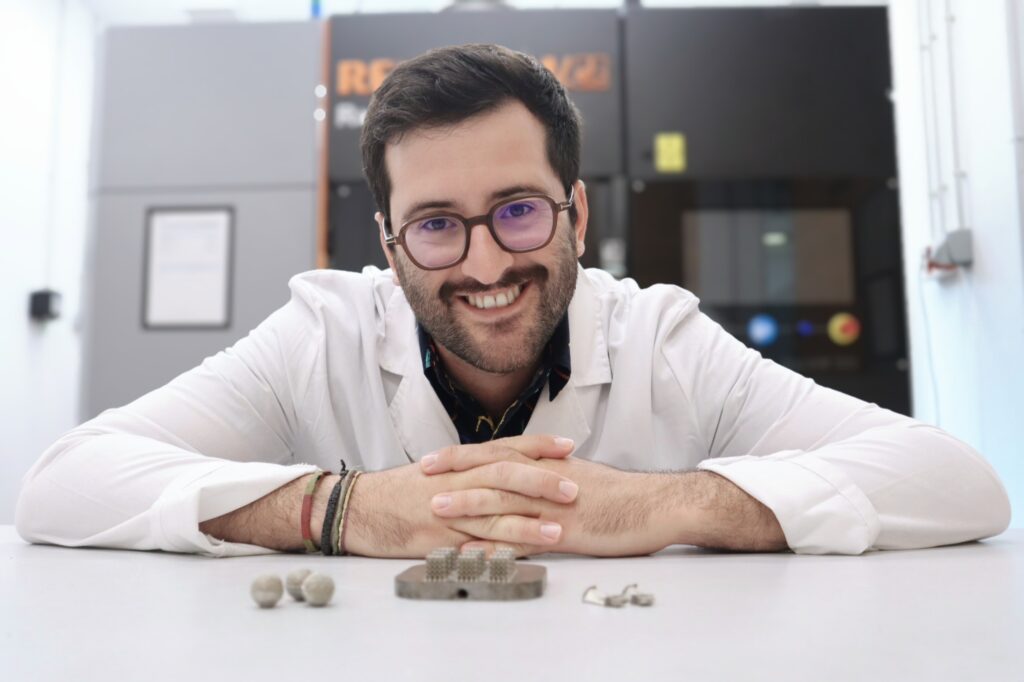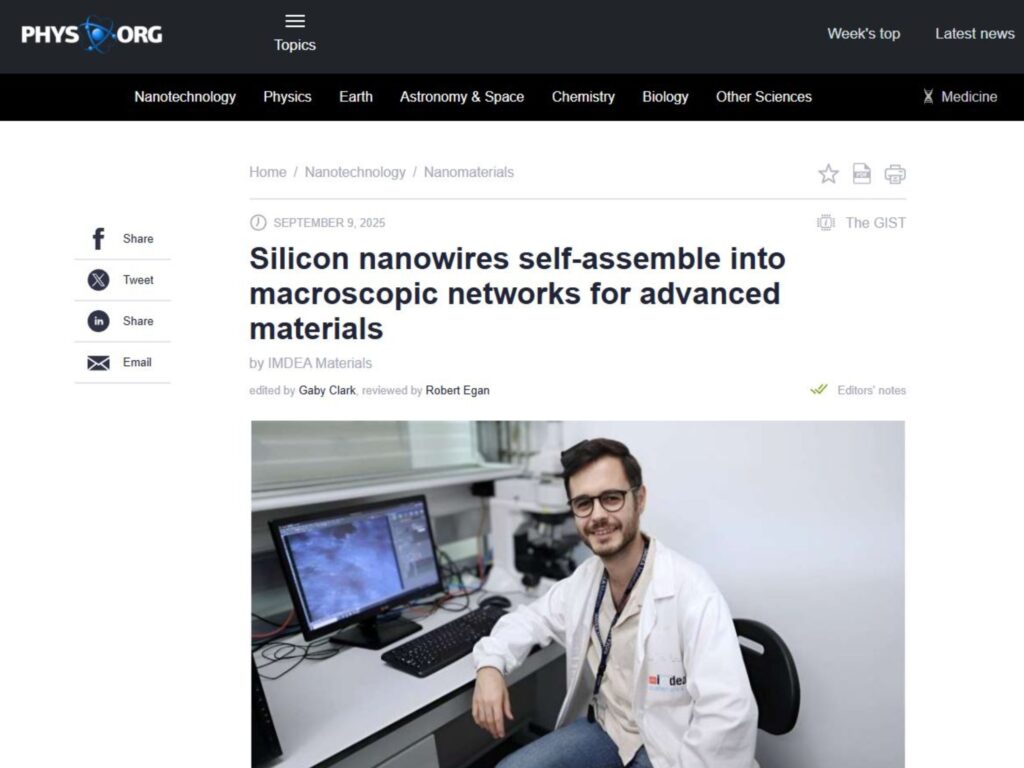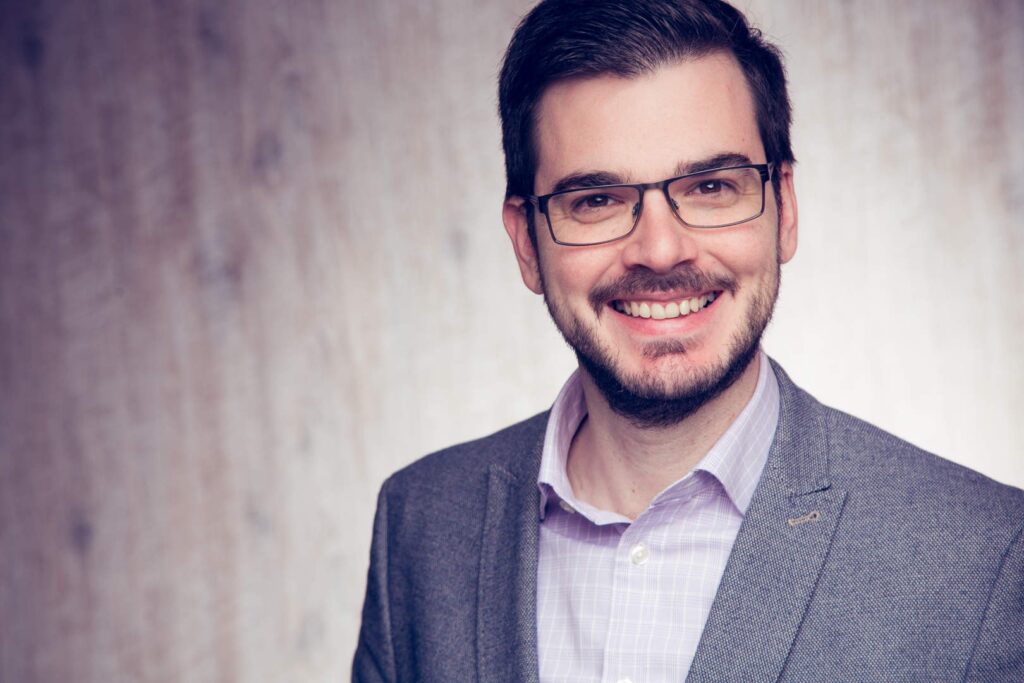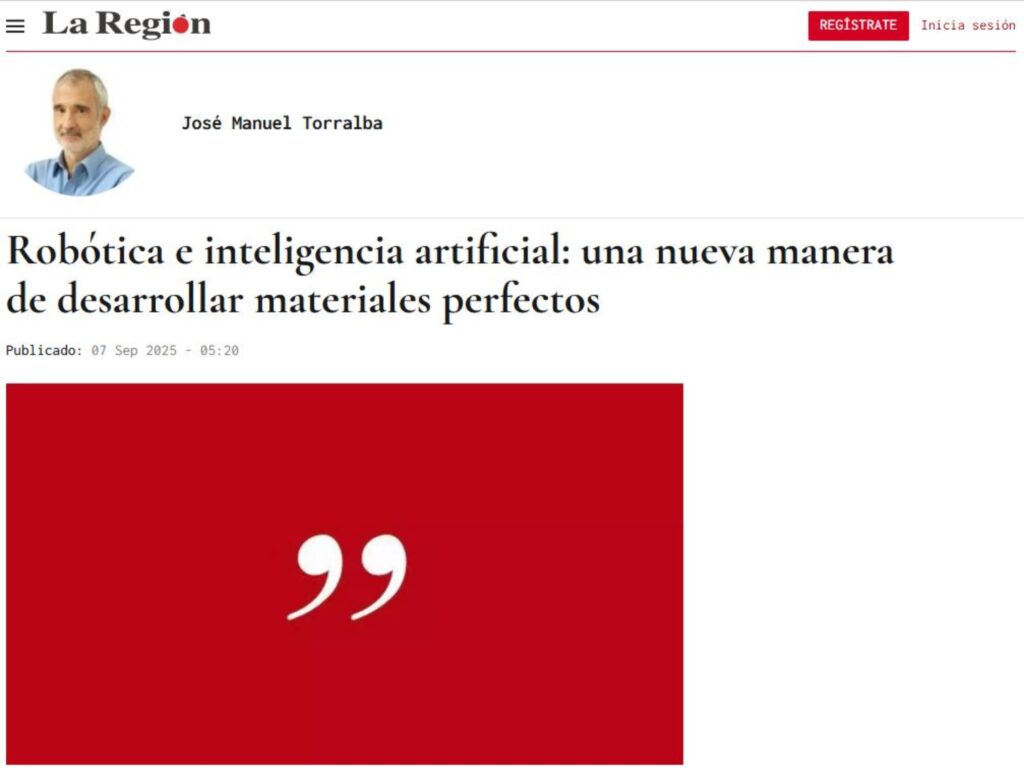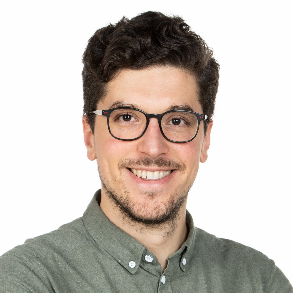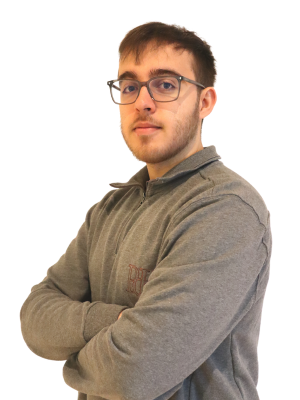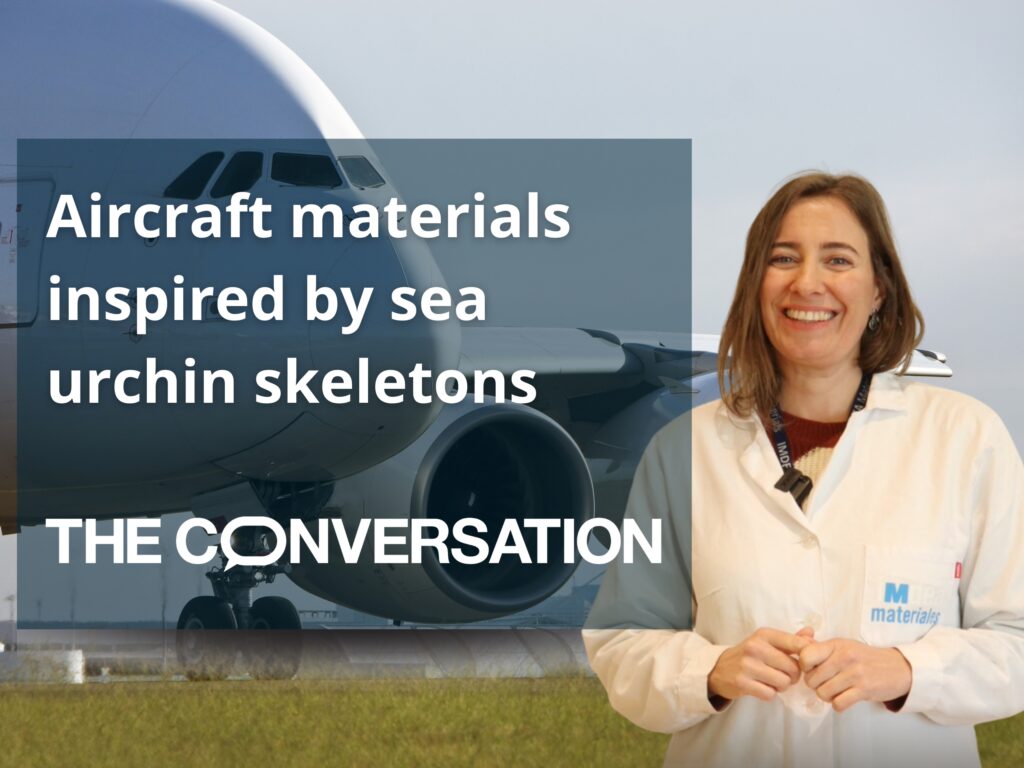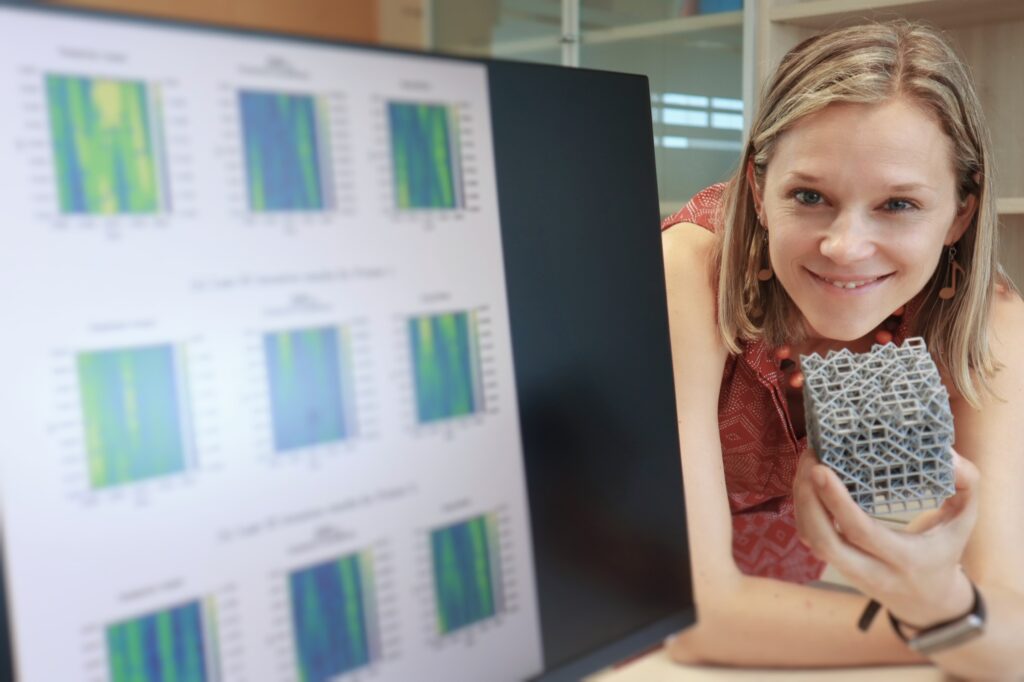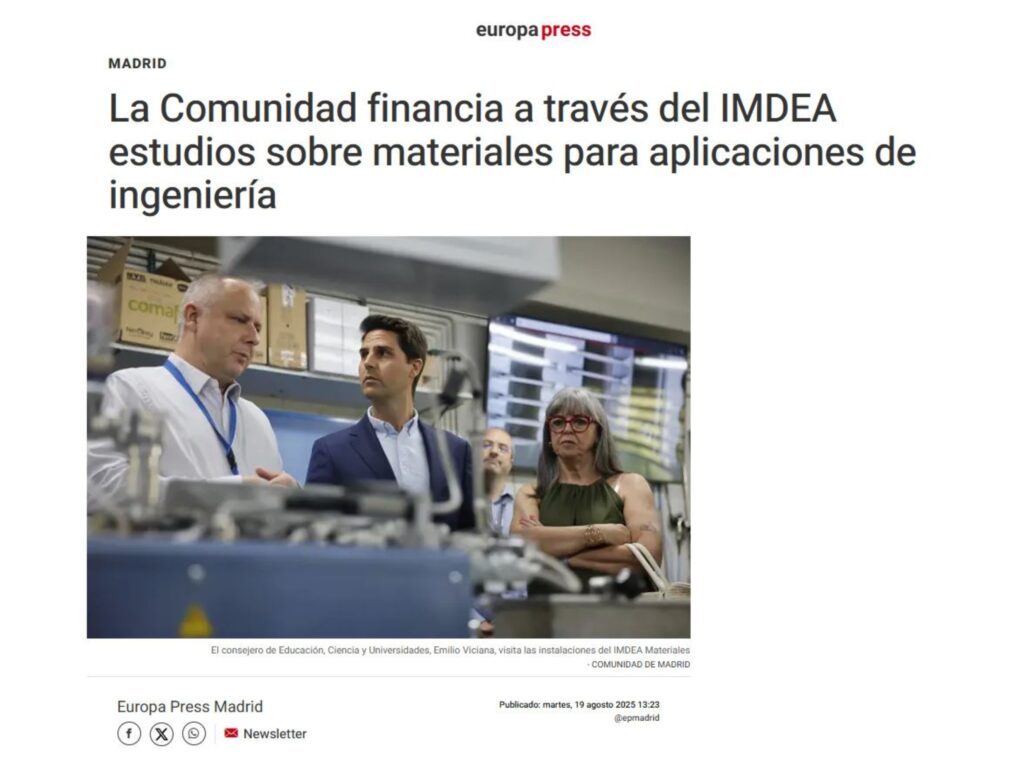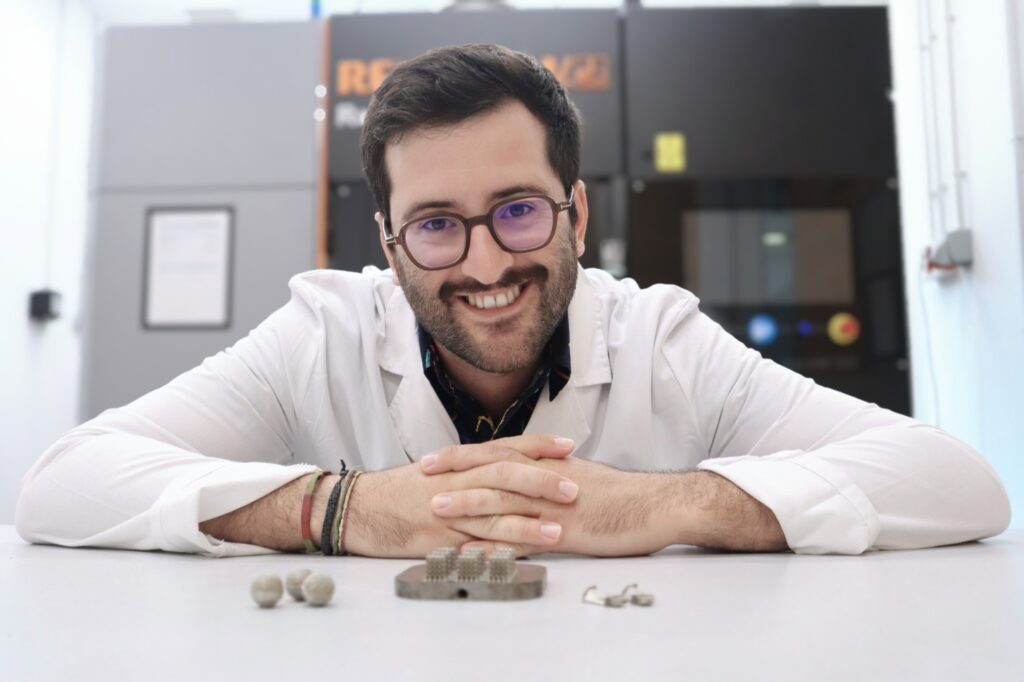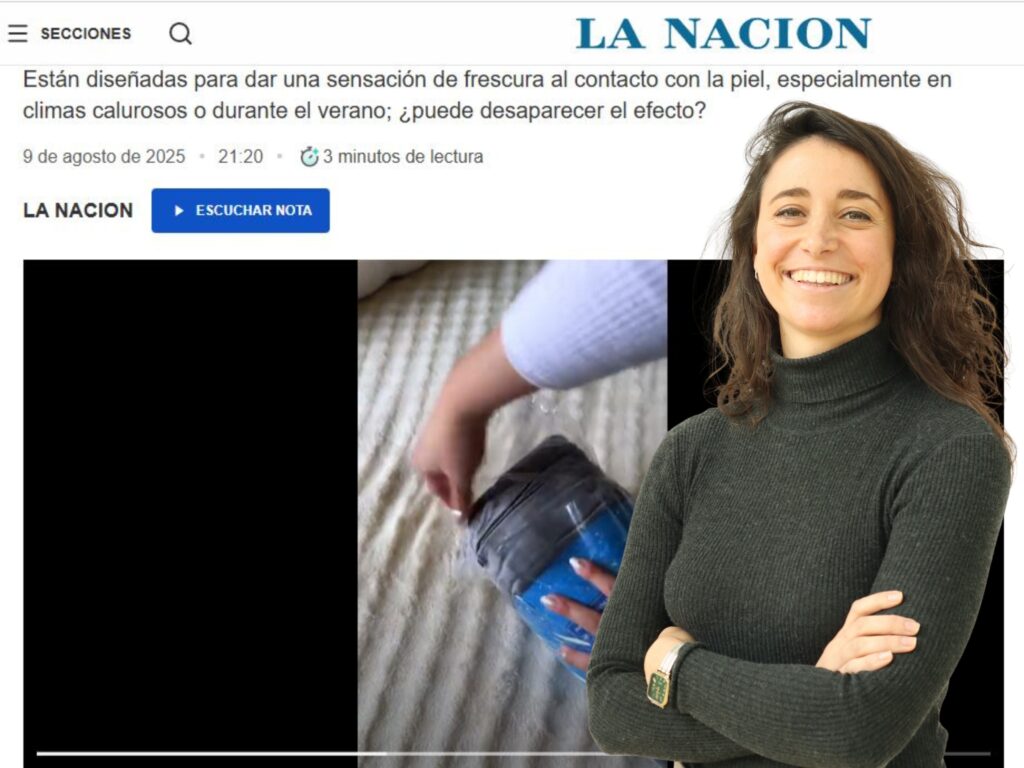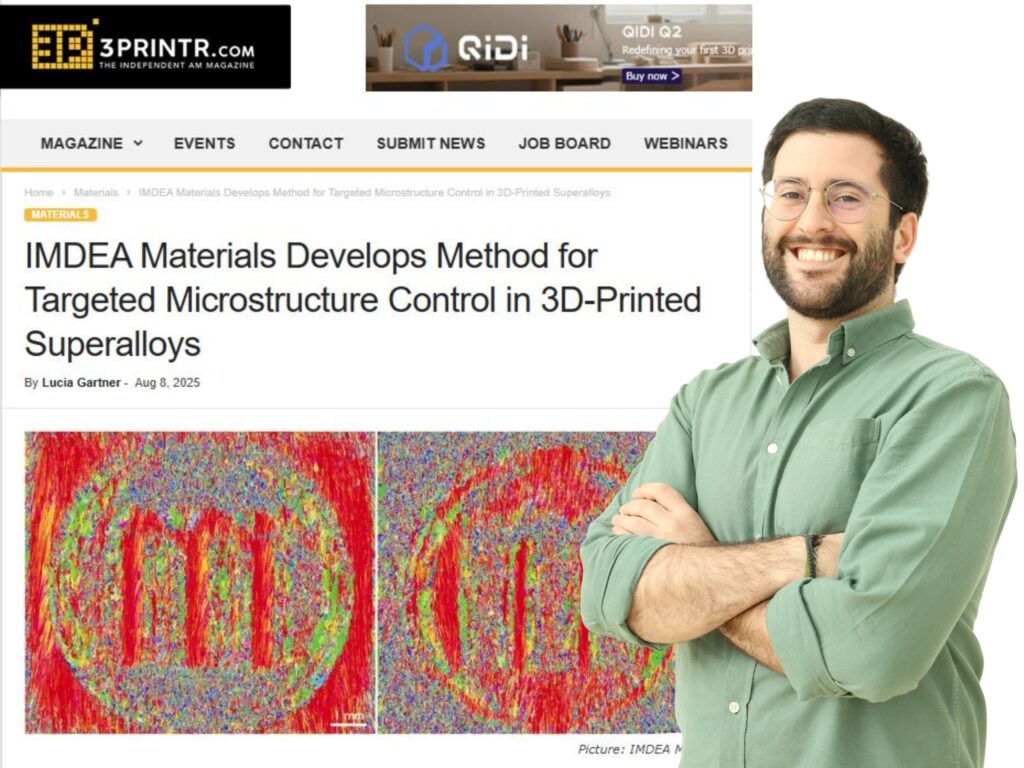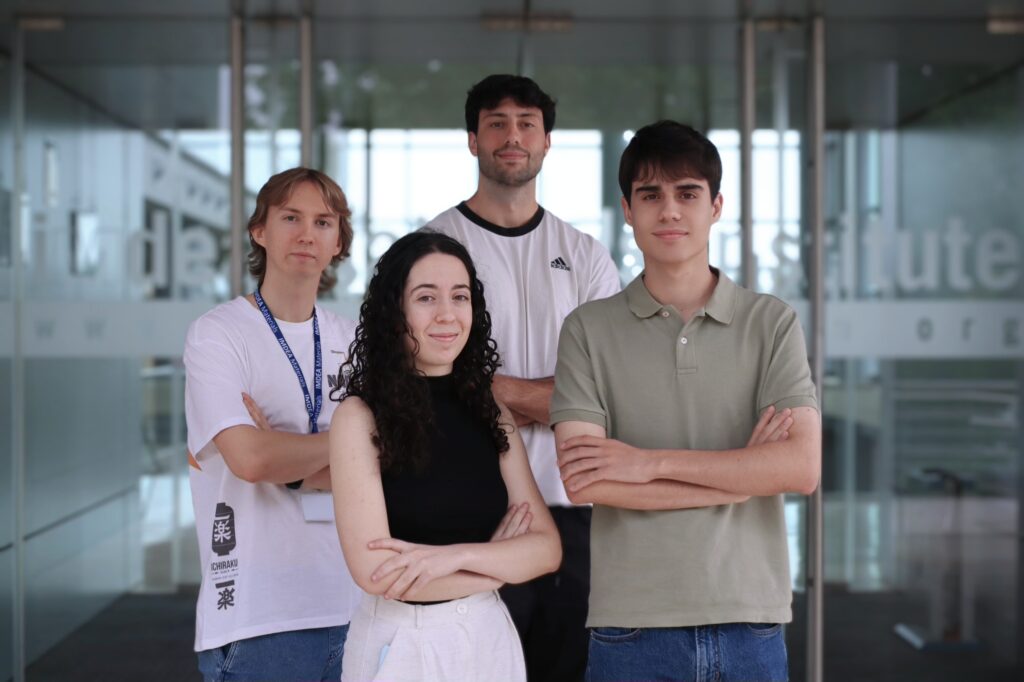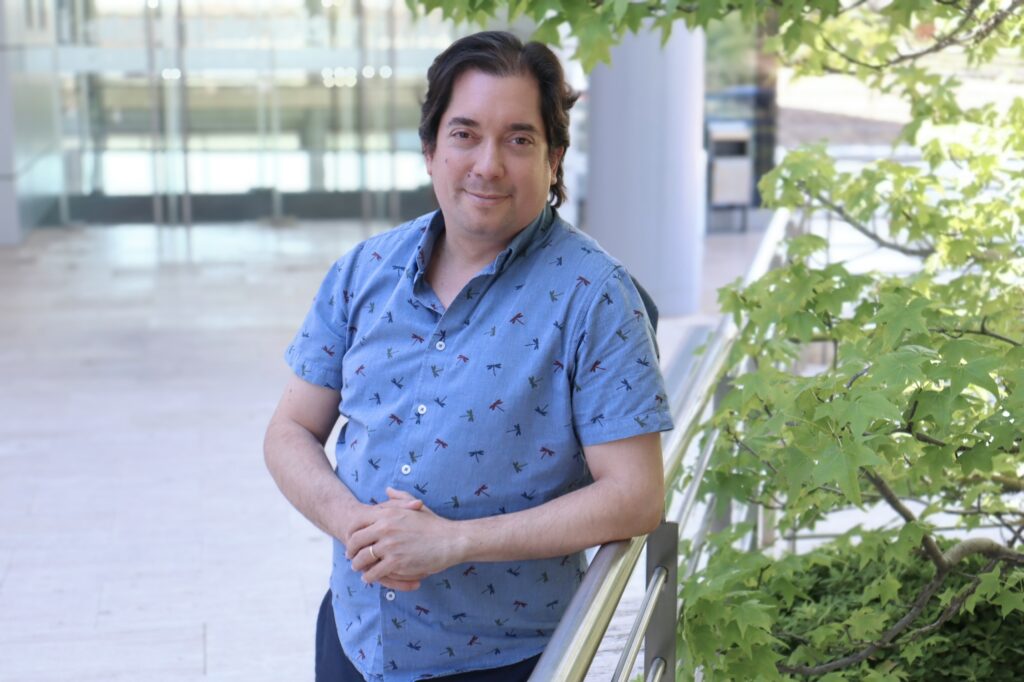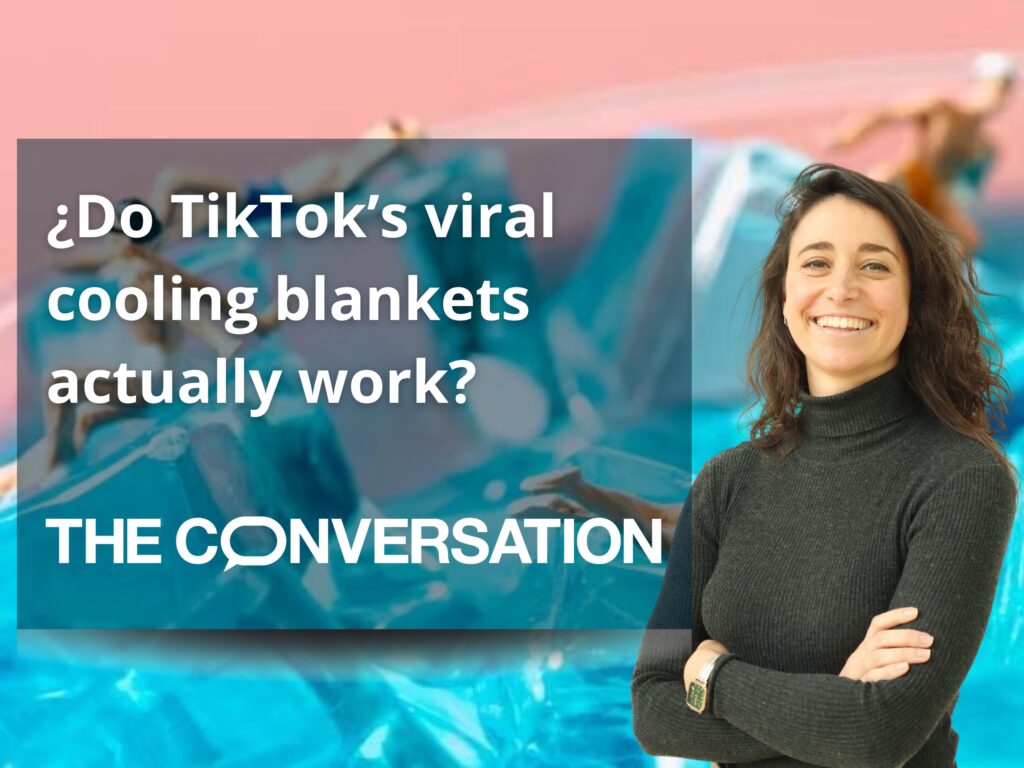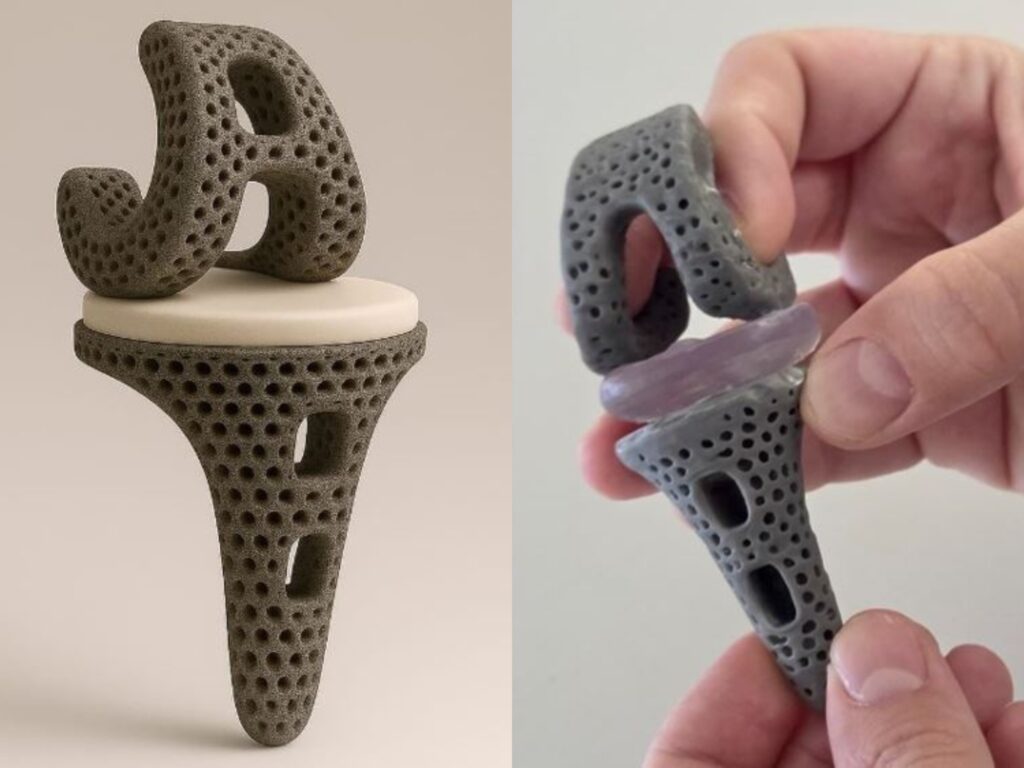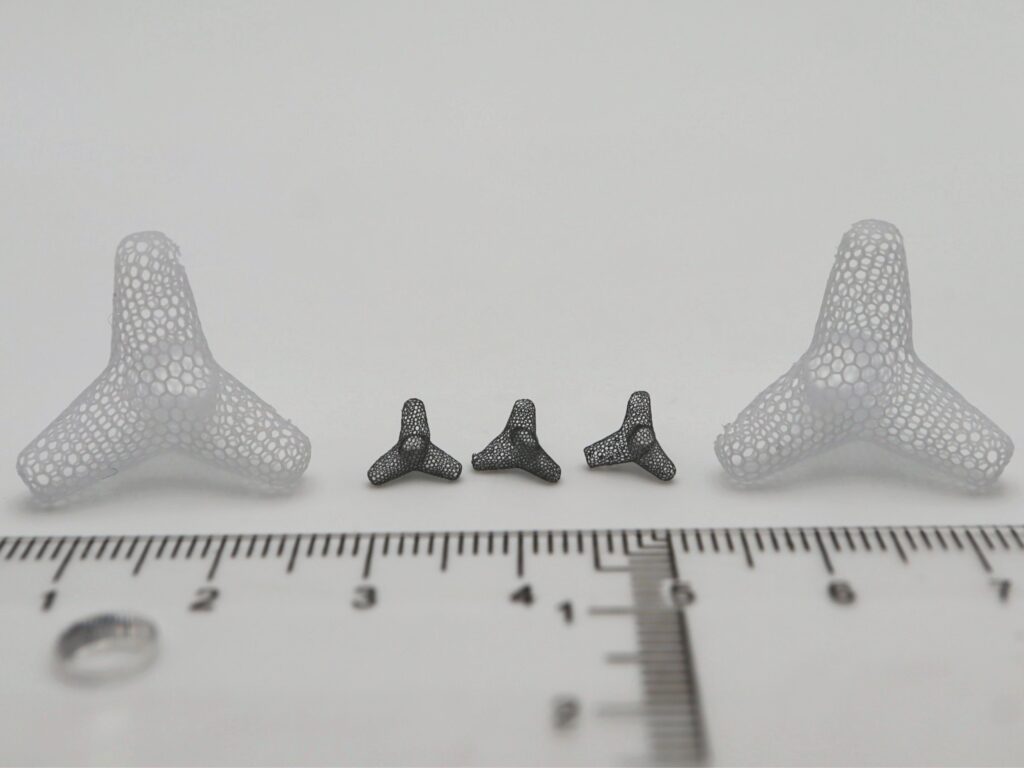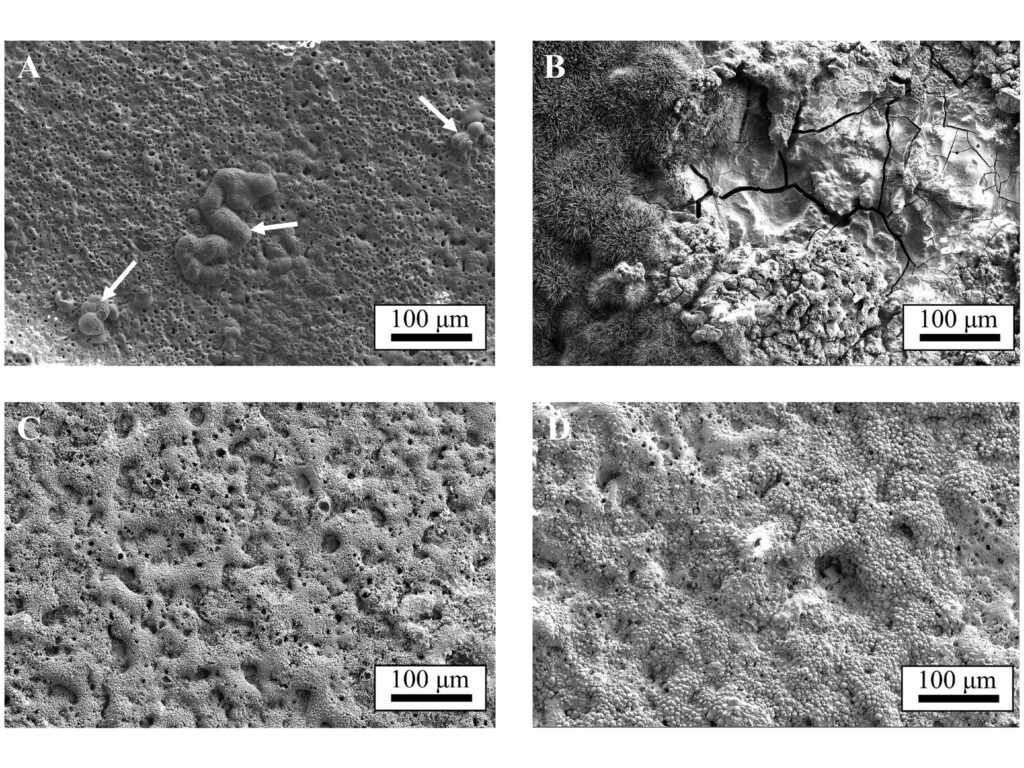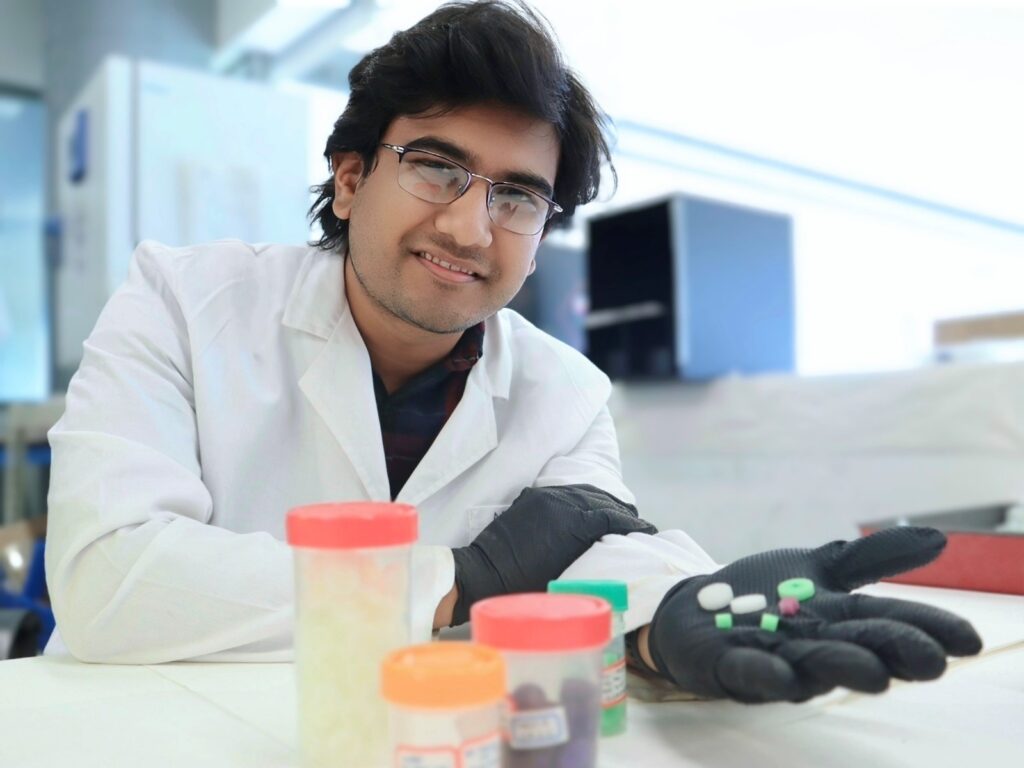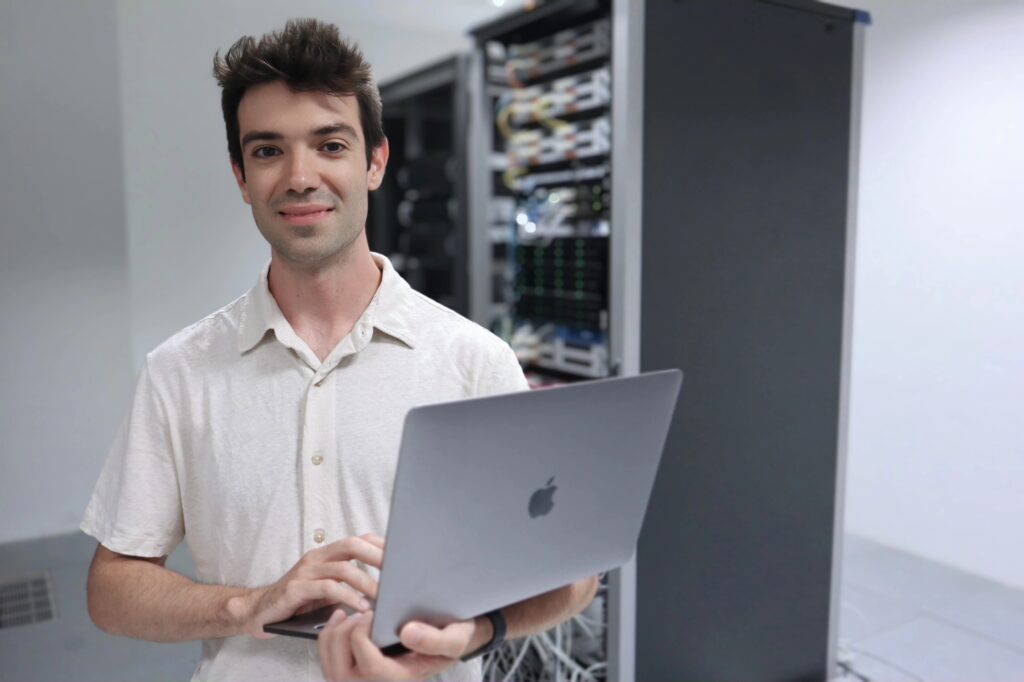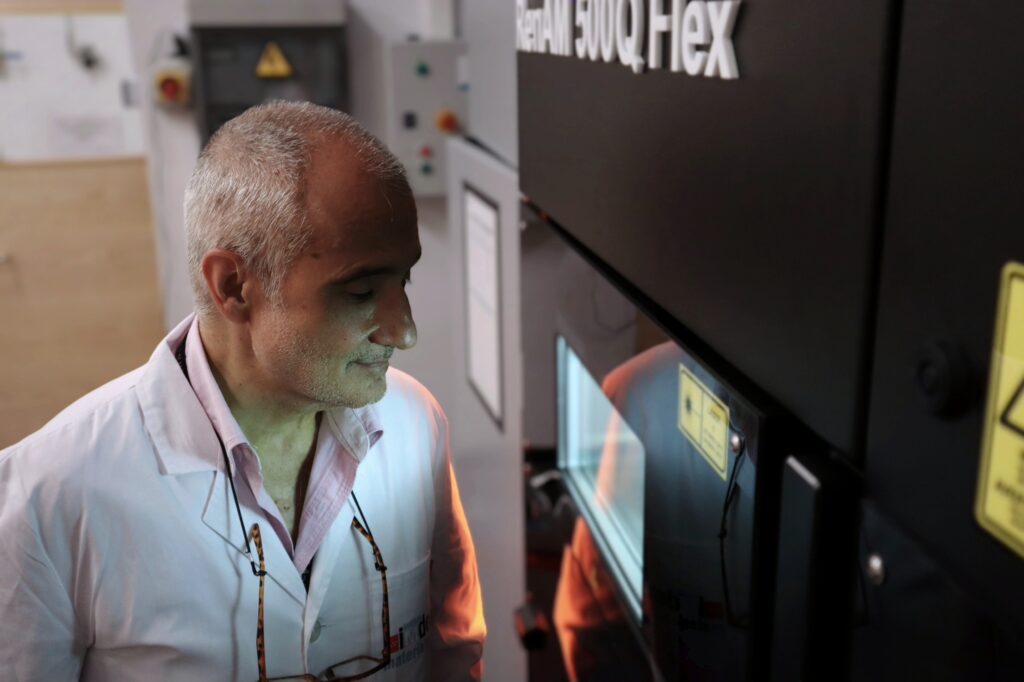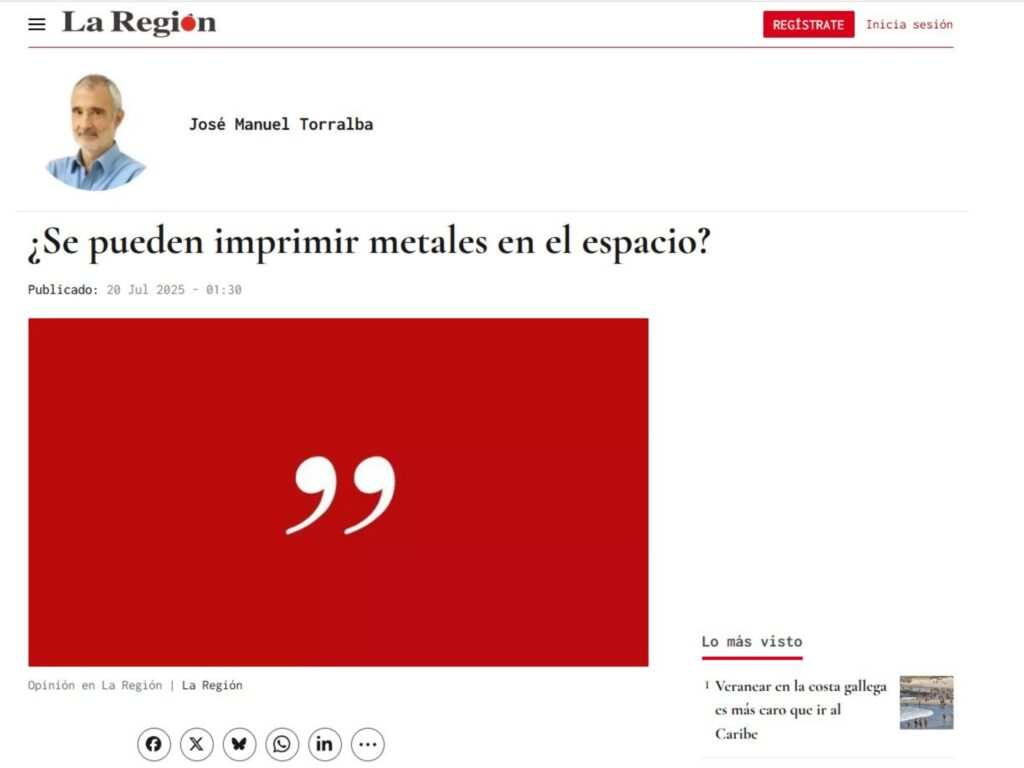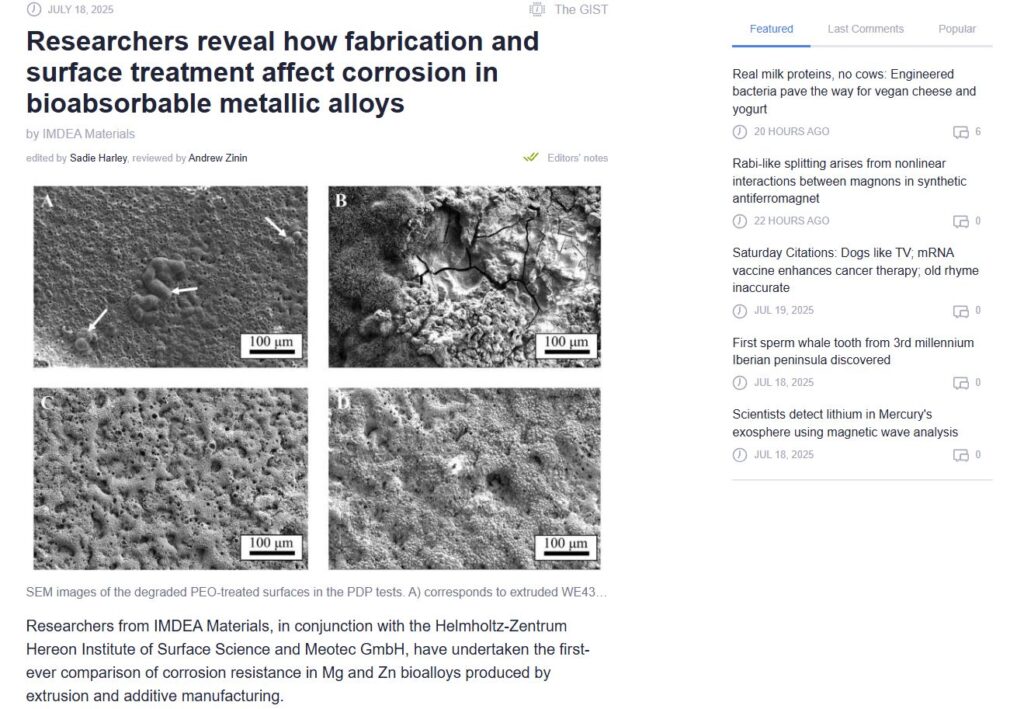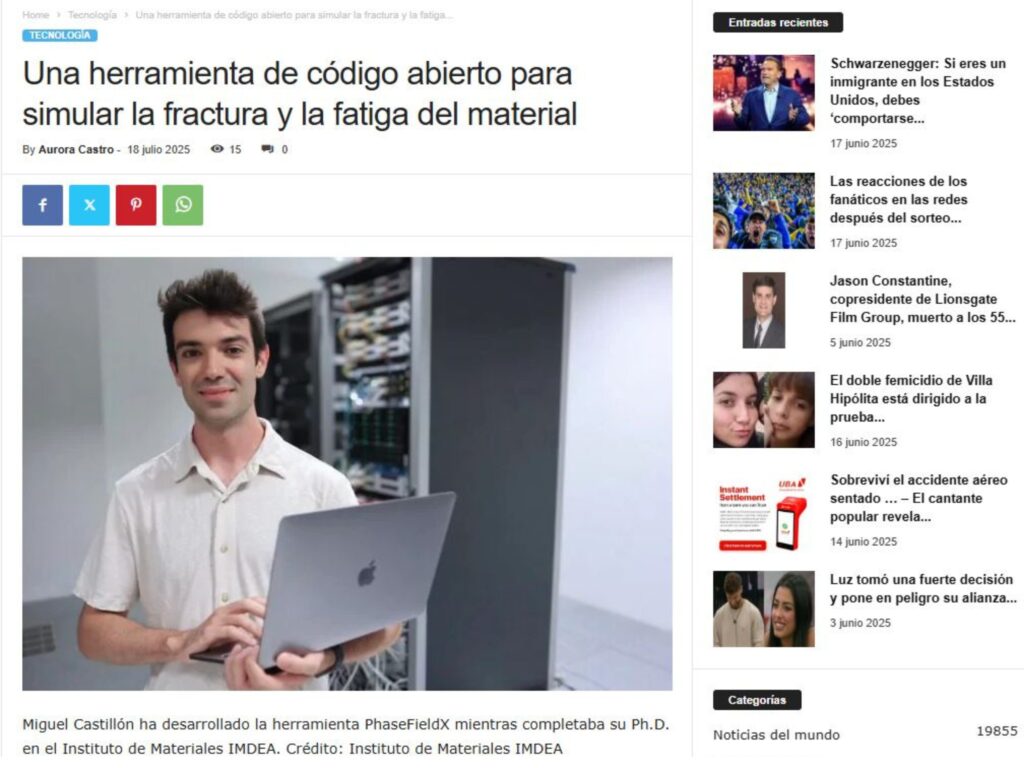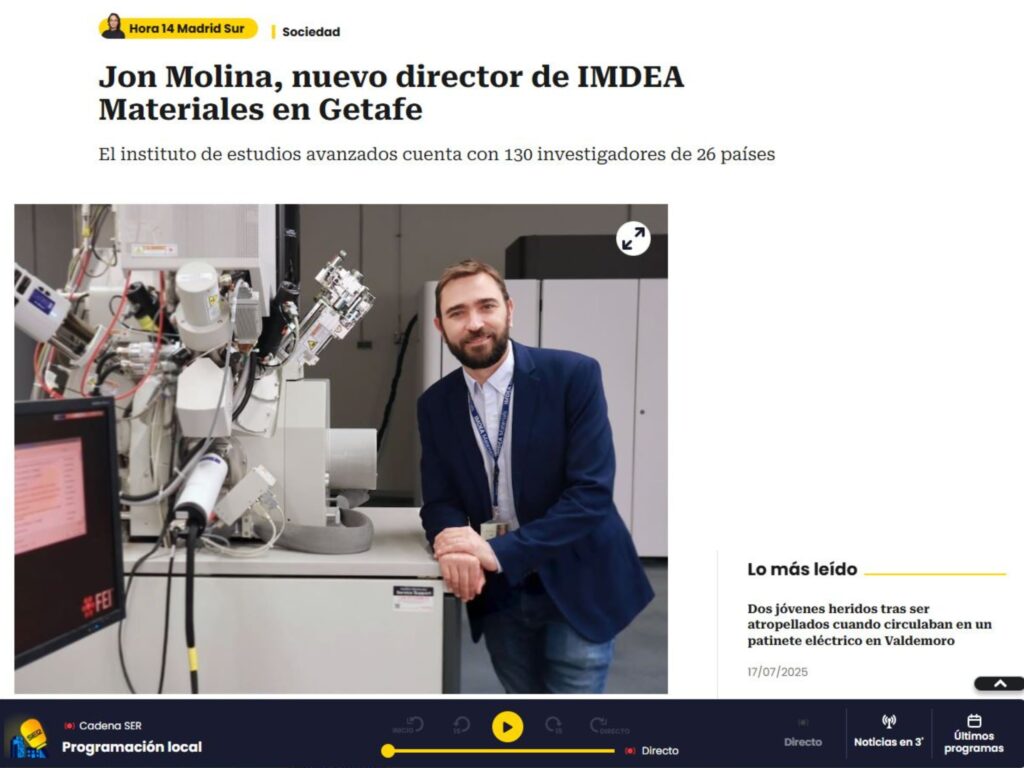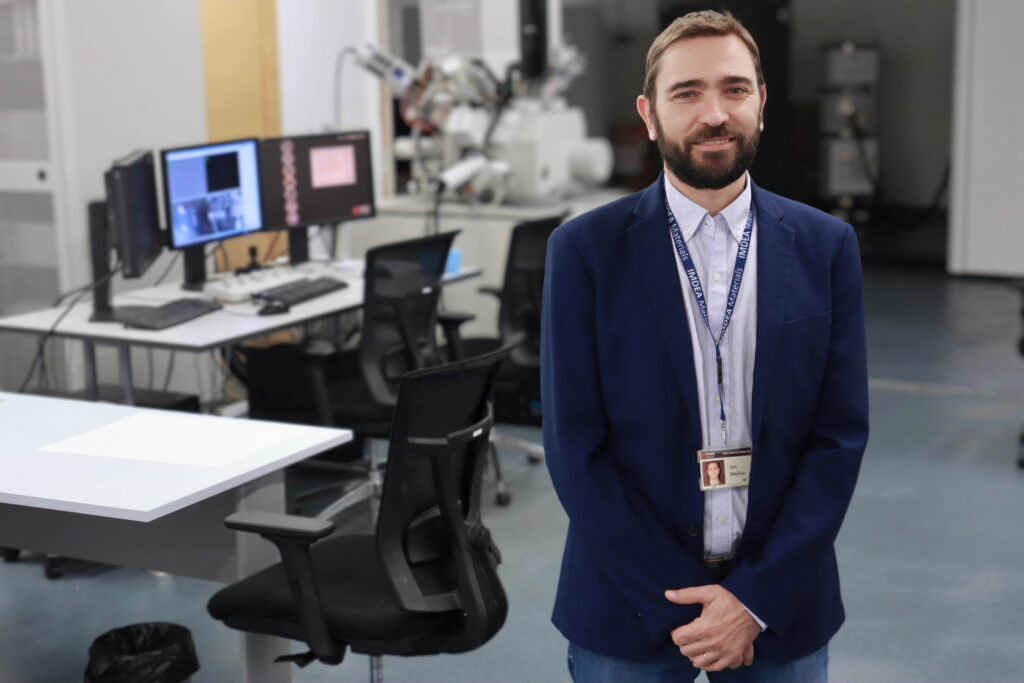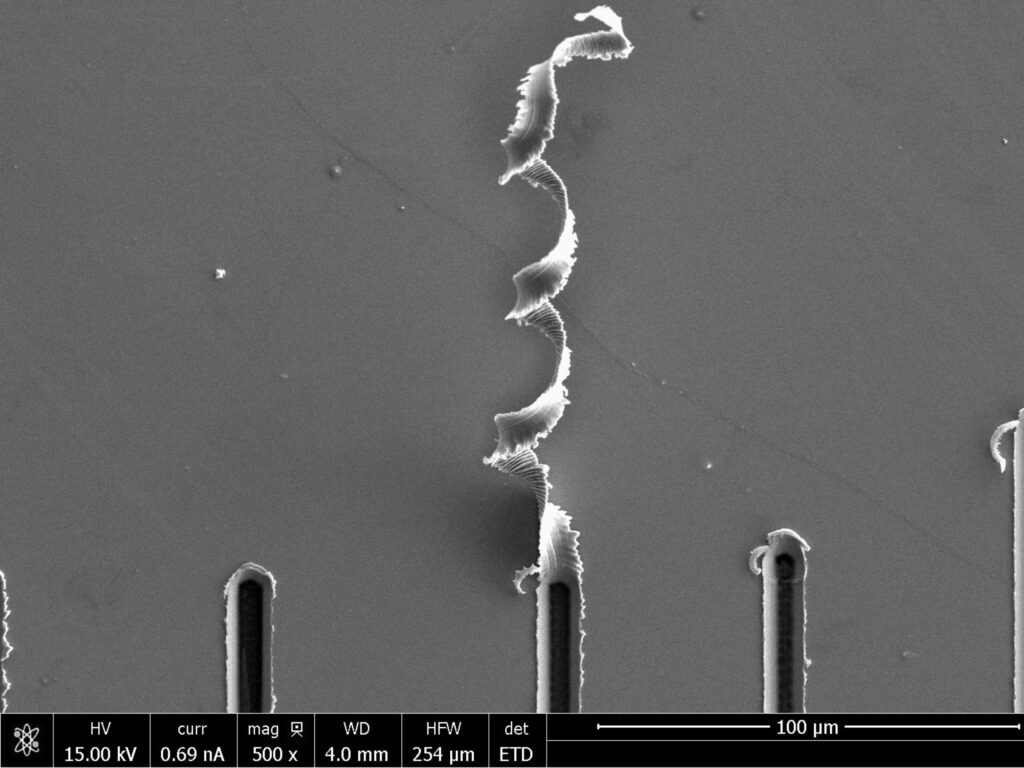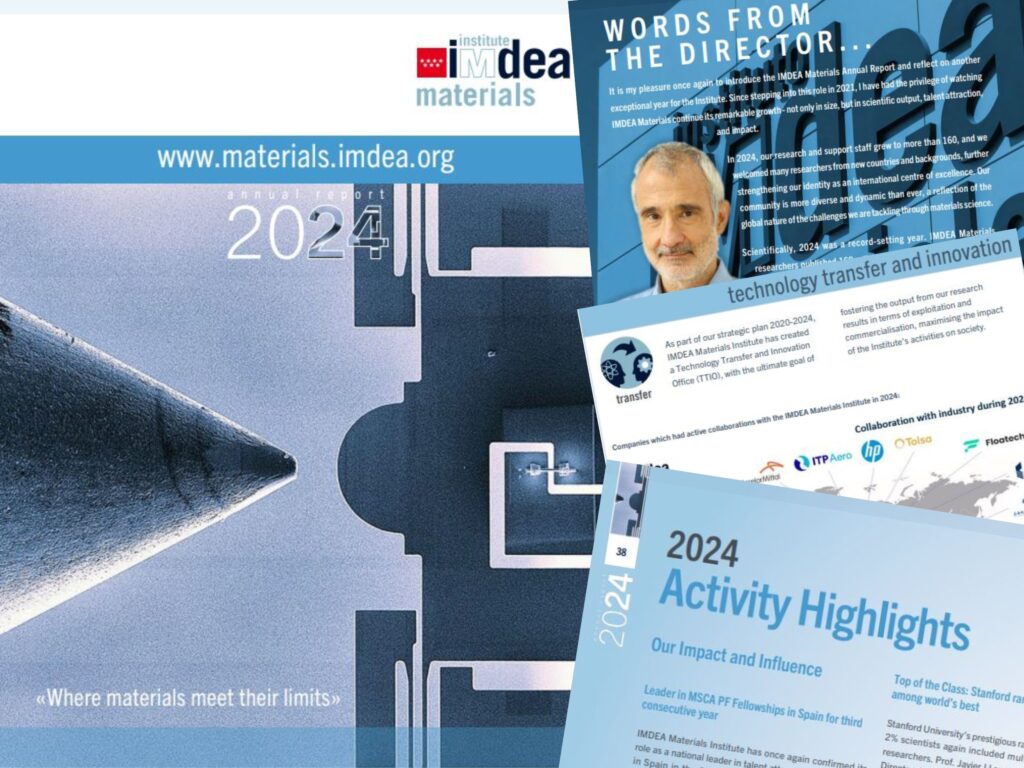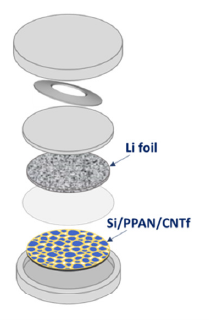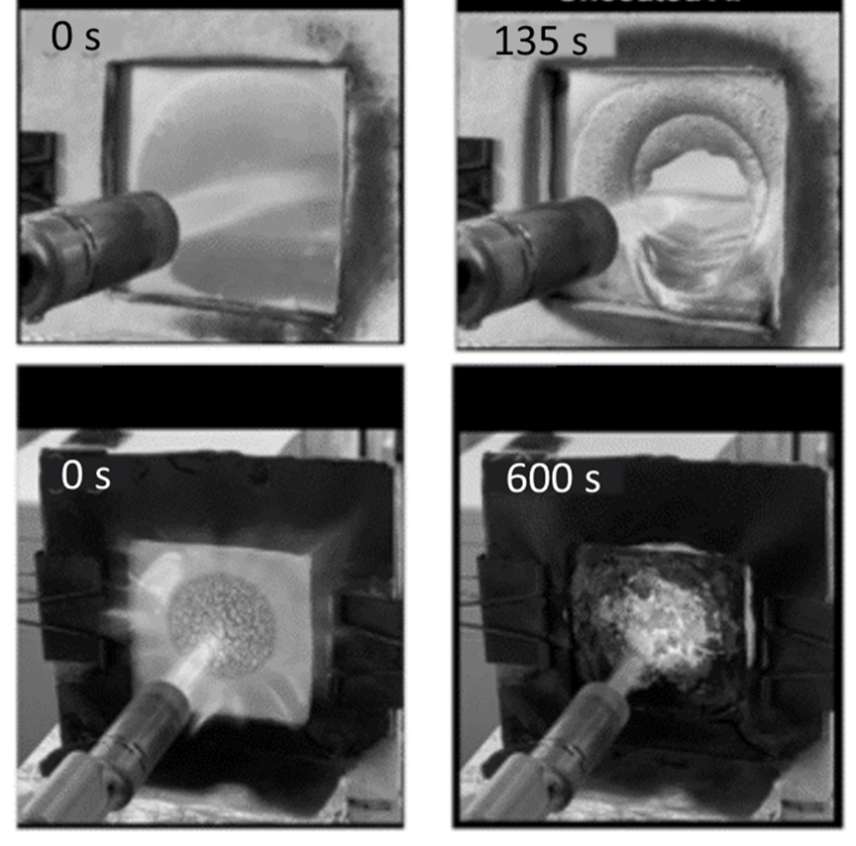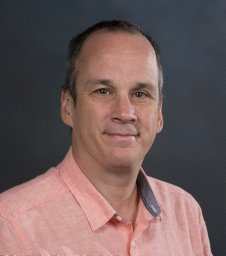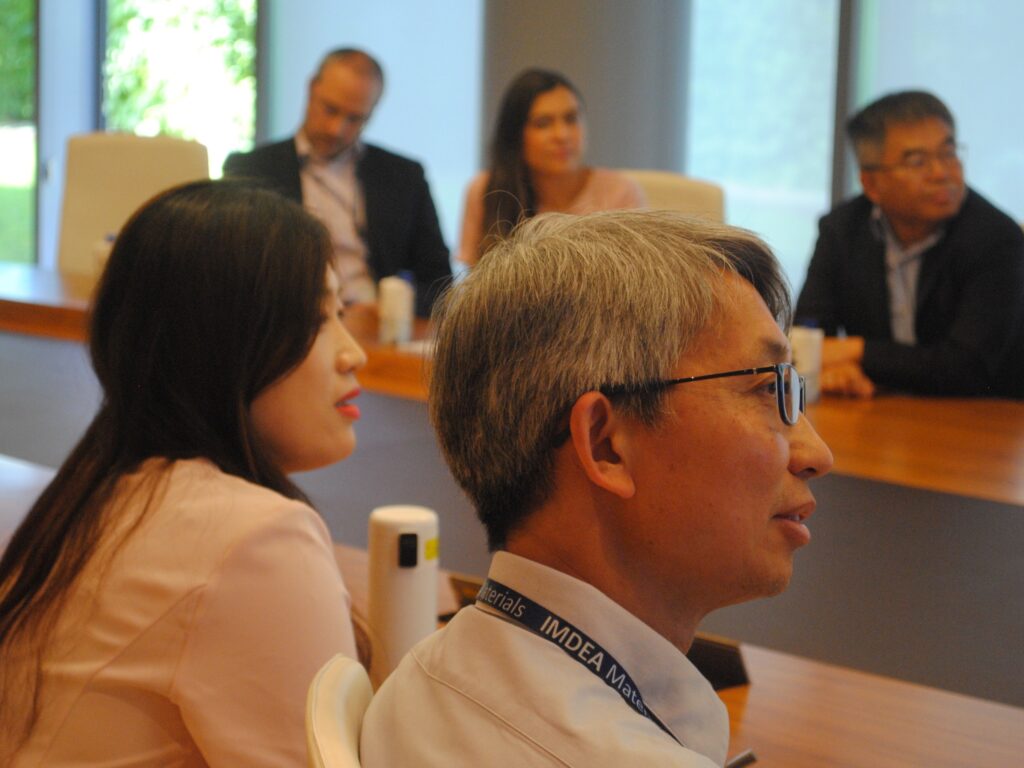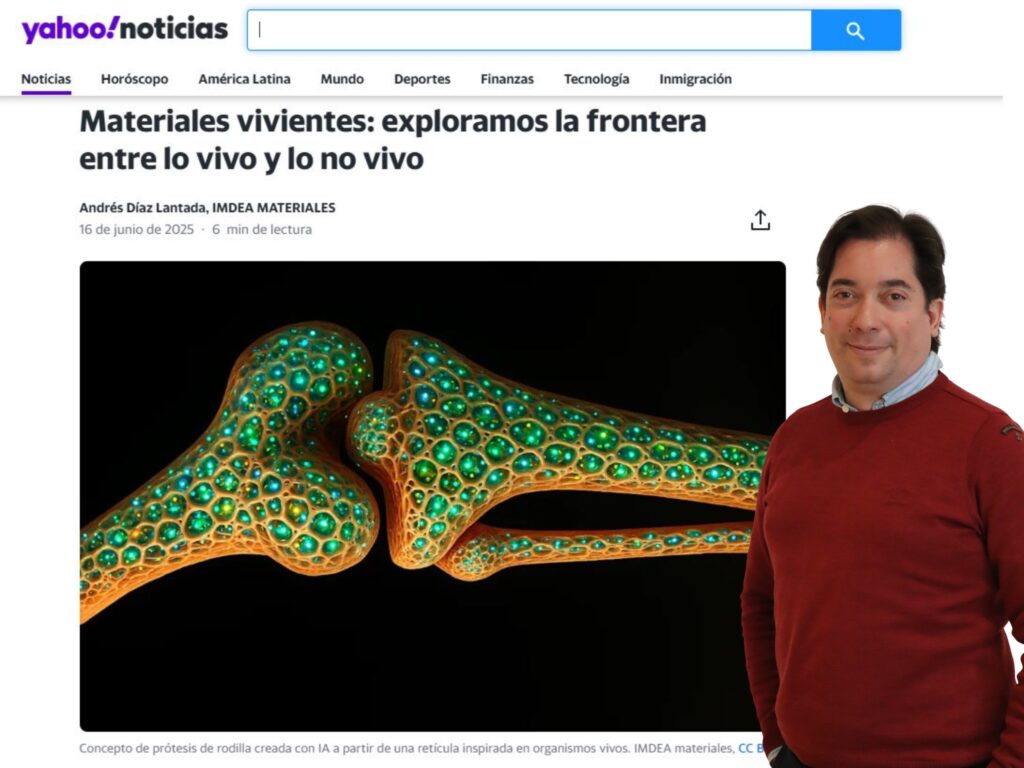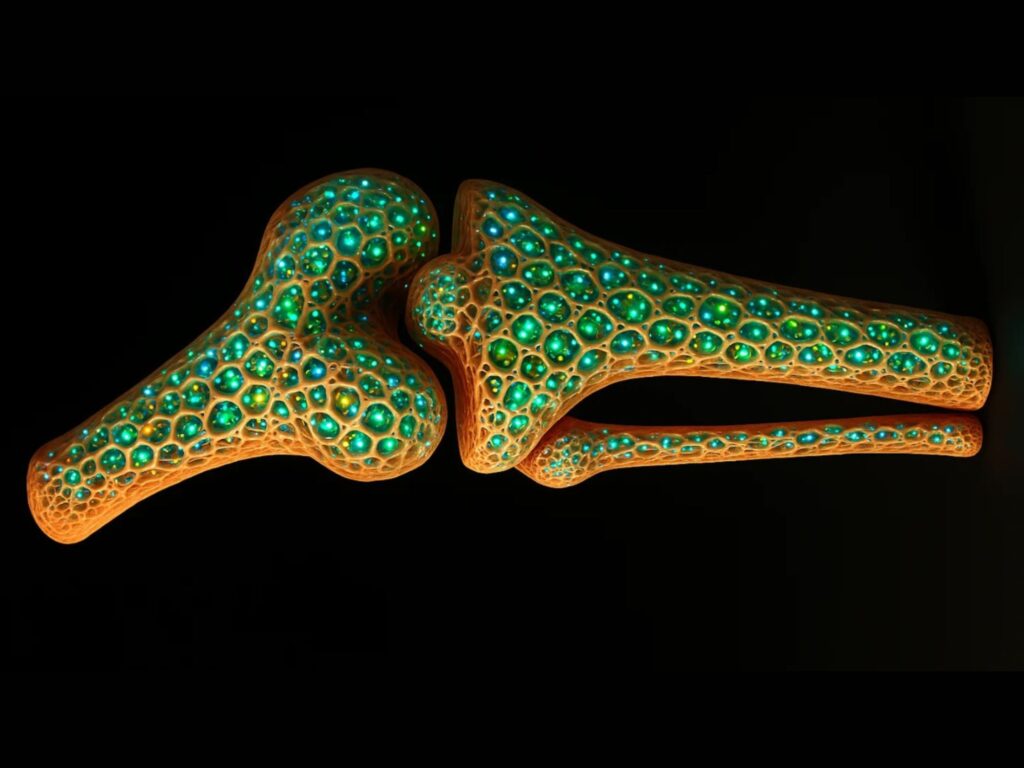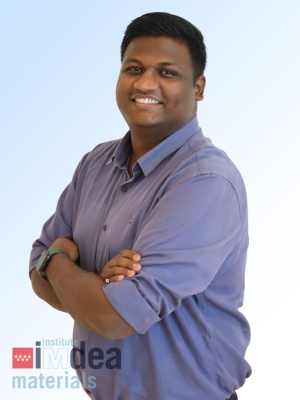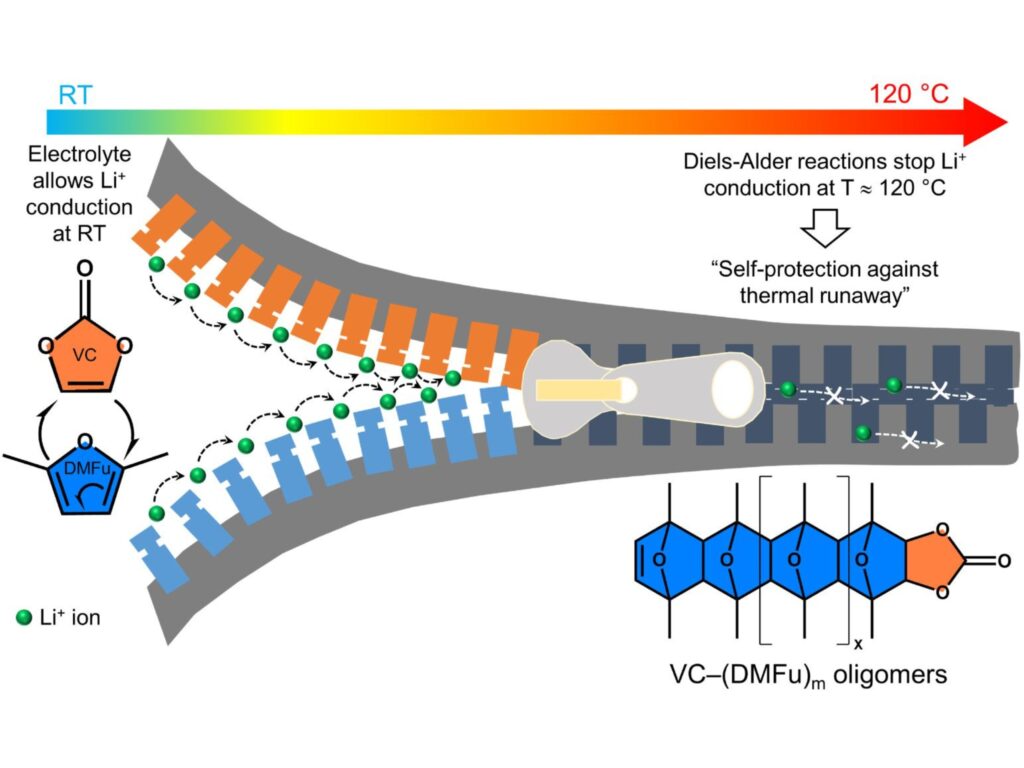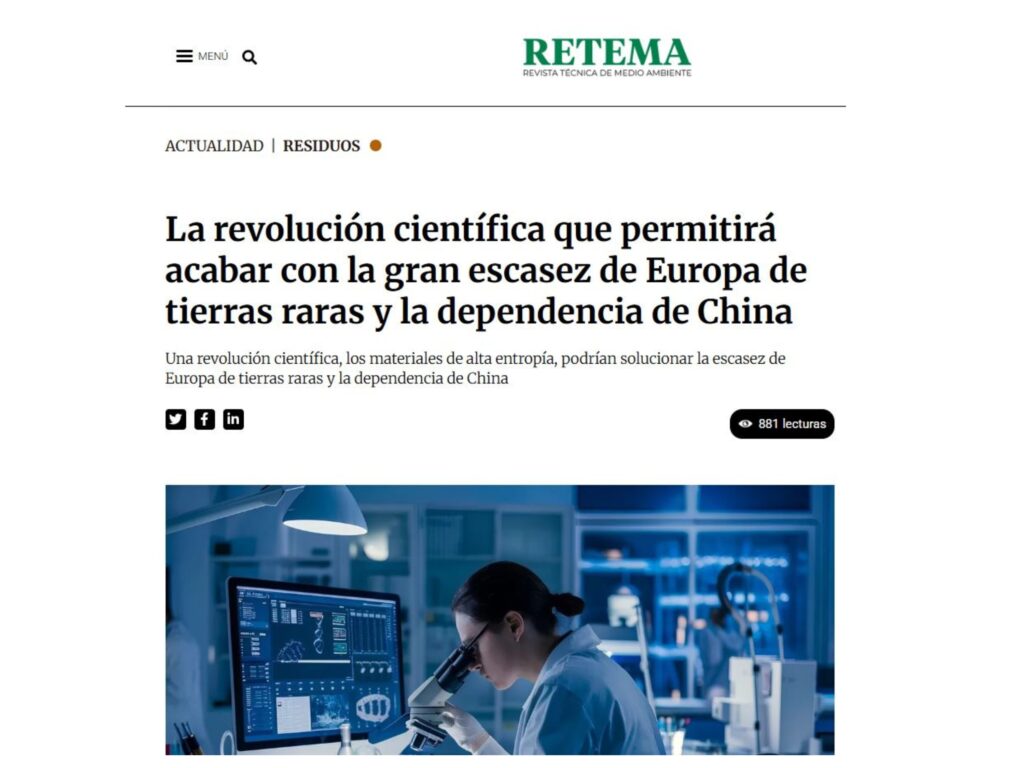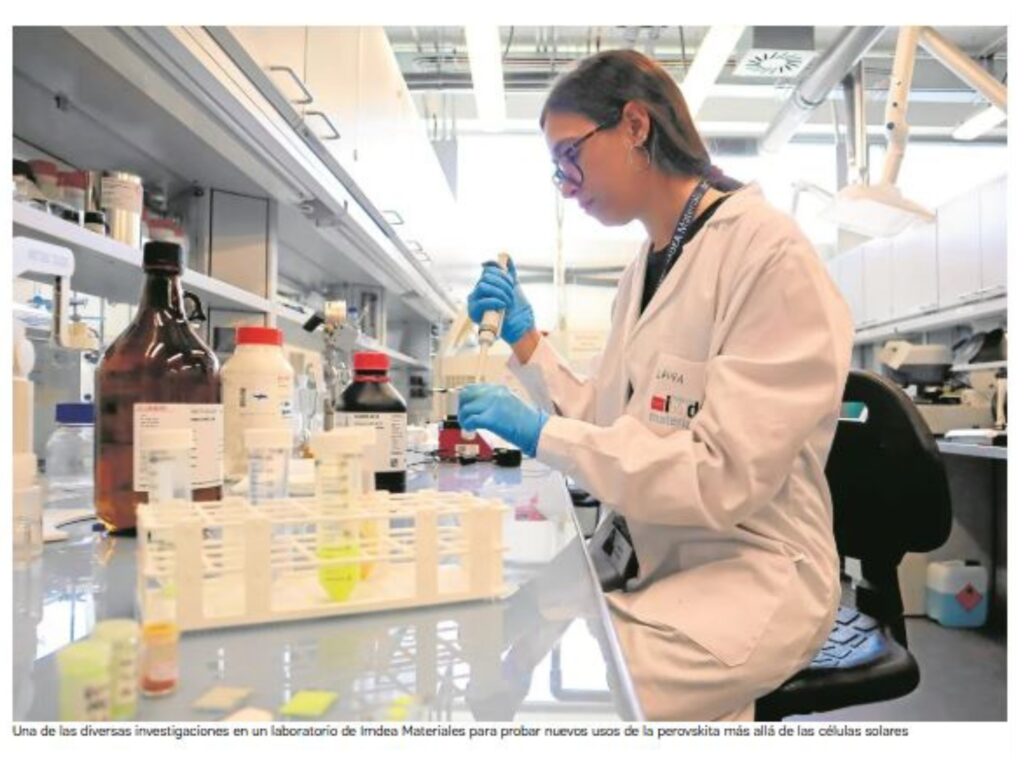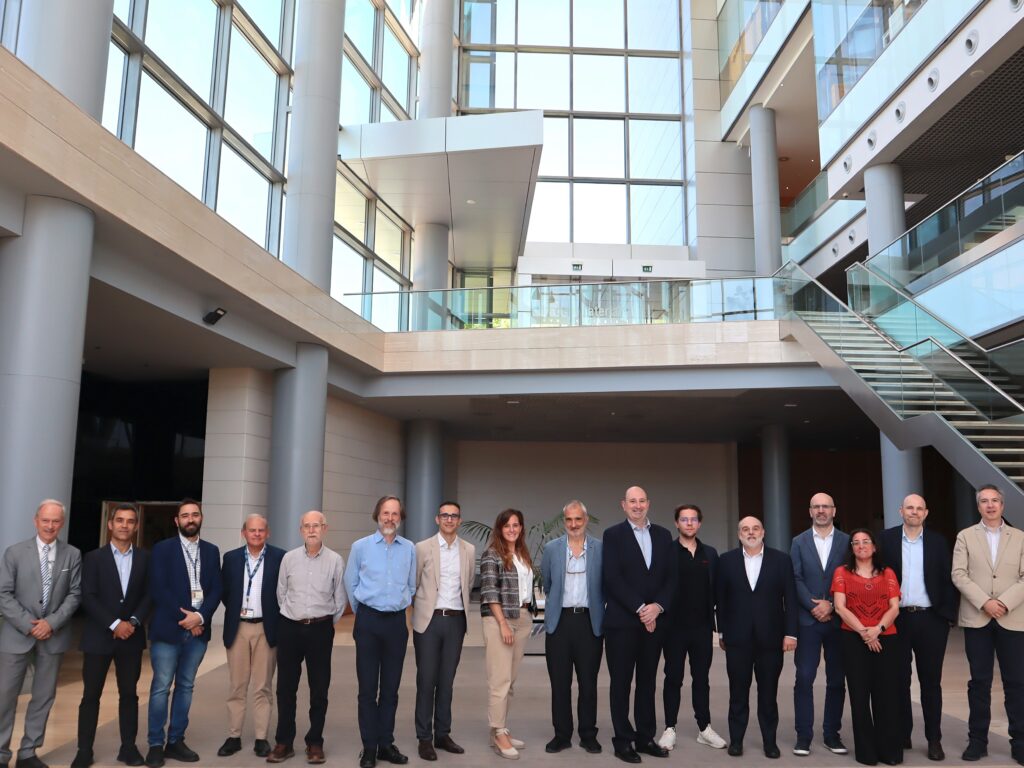IMDEA MATERIALS PROOF-OF-CONCEPT CALL 2026 - MATERIALISE GOAL AND DESCRIPTION There is a gap between the progress made through research funding and what industry and investors view as an interesting commercial opportunity. While researchers usually
Seminar by Prof. Dr. Dan Xiao from Hochschule für Technik und Wirtschaft Dresden, entitled “High-performance Recyclable Fire Retardant Polymer Composites/Nanocomposites Enabled by Electron Beam Treatment” – on December 15th, 2025, at 11:30 AM, in the Seminar Room.
Abstract: Trillions of dollars of polymer products, such as wires and cables, hydrogels, tires, heat shrinkable films, wood plastic for floor, tubes, etching, disinfection, harm removal, 3D printing, and coating etc. have been recreated by electron beam (EB) technology every year. Over the past
GangGang Xu
Zied Regaieg
ATENEA programme to build on IMDEA Materials’ strong legacy of MSCA postdoctoral research success
At IMDEA Materials Institute, Dr. JoAnn Ballor is leading the UTIFE project, exploring ultrafine eutectic Ti–Fe alloys for next-generation metal 3D printing. This cutting-edge research with applications in aerospace and beyond has been possible thanks to a Marie Skłodowska-Curie Actions (MSCA)
Pushing the boundaries of metal 3D Printing: IMDEA Materials leads research on ultrafine eutectic Ti-Fe alloys
Developing metals specifically for additive manufacturing, also known as metal 3D printing, is increasingly important. This process imposes thermal conditions and solidification rates that differ significantly from conventional fabrication methods. At IMDEA Materials Institute, Dr JoAnn Ballor is
From Madrid to the world of materials: Prof. Javier LLorca honored with the 2025 Miguel Catalán Award
Prof. Javier LLorca’s recognition as the recipient of the 2025 Miguel Catalán Award consolidates his position as one of the leading figures in the fields of engineering and materials science.Scientific Director of the IMDEA Materials Institute, leader of the Bio/Chemo/Mechanics of Materials research
FYA of Jinyi Huang entitled “Silk Fibroin-Based Composite Piezoelectric Scaffolds for Articular Cartilage Regeneration”. November 21st, at 11:30 am in the Seminar Room.
IMDEA Materials researchers present new high-entropy superalloy to push jet engine performance to new limits
A novel cobalt (Co)- and nickel (Ni)-based high-entropy superalloy (CoNi-HESA) capable of withstanding higher operating temperatures could prove a step toward more powerful and fuel-efficient aircraft engines. The development and manufacture of the new CoNi-HESA is outlined in a recently
Robots that invent new materials
José Manuel Torralba, IMDEA MATERIALS What role does artificial intelligence play in a materials factory? How can it help choose the best combination of ingredients to achieve specific properties for a wide range of purposes? It turns out that AI is becoming essential for digesting the hundreds
Thermoset-based polymer composite material, method of manufacturing and associated uses thereof
Patent details Status European patent filed Inventors De-Yi Wang, Xiang Ao, Yunhuan Liu Application number EP25382313.2 Applicant IMDEA Materials Institute Priority date 31/03/2025 Transfer opportunity Technology
Structure comprising a first, rapidly degradable part and a second, slowly or non-degradable part
Patent details Status European patent filed Inventors Javier LLorca Martínez, Jennifer Patterson, Jon Mikel Molina Aldareguia, Andrés Díaz, William Solorzano, Alexander Kopp, Simon Poestges Application number EP25153513.4 Applicant IMDEA
Towards lab-grown organs: IMDEA Materials advances the field of tissue engineering
At IMDEA Materials Institute, a new line of research is emerging with the potential to change how we treat injuries and degenerative diseases. The goal: to create tissues and implants capable of regenerating parts of the human body, from bone and cartilage, to ligaments and tendons. “I want to
Tianyi Ma
IMDEA Materials and INEGI partner to accelerate innovation in advanced materials and technologies
IMDEA Materials Institute has further strengthened its commitment to international collaboration in materials science research, development, and innovation programmes through a new Framework Collaboration Agreement (FCA) with INEGI. The Institute of Science and Innovation in Mechanical and
PhD Defense of Mingyang Zhang, entitled “Fire-safe lithium-ion batteries: material, assessment, and mechanism” – On November 20th, 2025, at 11:00 AM.
The PhD defence will take place on Aula 31, first floor, at the Polytechnic University of Madrid. How to get there: Campus, Calle del Prof. Aranguren, 3, 28040 Madrid. The dissertation is titled “Fire-safe lithium-ion batteries: material, assessment, and mechanism”. It has been advised by
IMDEA Materials joins international efforts in advanced materials innovation for a low-carbon future
IMDEA Materials Institute recently took part in the Spain–China Innovation Forum in Advanced Materials for Low Carbon Transition and Industrial Competitiveness, held in Beijing, China. Represented by our Director of Projects and Technology, Miguel Ángel Rodiel, the forum aimed to strengthen
Researchers develop multifunctional flame-retardant foam with strong antibacterial properties
A new study combining fire safety, hygiene, and sustainability has led to the development of a multifunctional polyurethane foam that resists flames and suppresses smoke, while also preventing bacterial growth. The new material, which also exhibits improved mechanical properties, could be
New alliance between IMDEA Materials and CIMNE to advance simulation and the development of new materials
The long-standing relationship between the IMDEA Materials Institute and the International Centre for Numerical Methods in Engineering (CIMNE) has entered a new stage with the signing of a framework collaboration agreement. This step forward in consolidating an already well-established
IMDEA Materials contributes to shaping the future of European 3D bioprinting
Home to several fast-growing biomaterials research lines, IMDEA Materials is also playing a role in resolving key issues relating to the standardisation and regulation of 3D bioprinting. Prof. Andrés Díaz Lantada, Principal Investigator of the institute’s Bioinspired, Smart and Living Materials
Dr. Benjamin Torres
Dr. Daming Chen
Ángela García Grech
Jiatong Han
Alexei Caballero Román
Dr. Gonzalo Álvarez Morales
IMDEA Materials’ EVSHIELD project advances through The Collider entrepreneurship programme
At IMDEA Materials, we continue to promote the transfer of scientific knowledge from the laboratory to industry and society. Researchers Prof. Dr. De-Yi Wang and Dr. Xiang Ao have recently participated in The Collider’s Opportunity Validation programme, an initiative by Mobile World Capital
FYA of Nafiseh Mollaei entitled “In situ EBSD analysis of the deformation mechanisms of a Zn-1wt%Mg alloy manufactured by laser power bed fusion”– Friday, October 24, 2025 at noon in the Seminar Room
Abstract: Zinc and its alloys have been recently considered promising candidates for biodegradable implants due to their excellent biocompatibility and stable degradation rates, despite their low mechanical strength. Among advanced fabrication technologies for medical components, laser
Methods for fabricating high-performance and lightweight lithium-ion batteries based on silicon and carbon nanotubes
Patent details Status US and PCT patents filed Inventors Afshin Pendashteh, Juan José Vilatela García, Sibani Biswal, Quan Nguyen, Matteo Pasquali, Ratnika Gupta, Steven Williams Application number 63/625,641, PCT/US2025/013097 Applicant IMDEA
Electric Machine
Patent details Status Spanish patent filed Inventors Juan José Vilatela García, Anastasiia Mikhalchan, Ana Inés de Isidro Gómez, David Camacho Pernil, Marta Isabel Ocaña Dominguez, Eva Novillo Diaz Application number P202530142 Applicant IMDEA
Seminar by Dr. Mert Celikin from University College Dublin, entitled “The Challenges in Metal Additive Manufacturing of Titanium & Magnesium-based Implants” – on November 3rd, at 12:00, in the Seminar Room.
Abstract: The first part of the talk will be on the challenges and the potential solutions of titanium (Ti)-based alloy processing through Additive Manufacturing (AM), also known as 3D printing. AM, which allows the realisation of a metallic component with complex geometries not achievable by
Seminar by Dr. Ni Qianqian from the National University of Singapore, entitled “Platform technologies for targeted delivery of RNA therapeutics” – on November 14, 2025, at 11:30, in the Seminar Room.
Abstract: Since the advent of COVID-19 mRNA vaccines, mRNA has become one of the most promising nucleic acid therapeutics. However, a major challenge now is how to deliver mRNA to targeting cells effectively and increase mRNA expression yield but de-risk potential toxicity to expand its clinical
Plastic deformation mechanisms of Mg-5.2Li alloy single crystals along different orientations studied by micropillar compression
Morphological, structural and compositional evolution of PtPdFeCoNi high-entropy alloy nanoparticles towards bifunctional oxygen electrocatalysis
Overcoming the specific stiffness/ductility trade-off in ZX50/SiC magnesium composites through solute-segregation interface strengthening and deformation-induced recrystallization
Harnessing disorder: metamaterials researchers achieve static mechanical cloaking and camouflage
A new collaborative study between IMDEA Materials Institute, China’s Northwestern Polytechnical University, the Chinese Academy of Sciences, Peking University, and the Southern University of Science and Technology, has achieved a significant breakthrough in the field of mechanical
Jimena de la Vega
FYA of Vittoria Squartecchia entitled “Phase-Field Modeling of Magnesium Alloy Degradation for Biomedical Applications” – 27th of October at 12:00 in the Seminar Room.
Abstract: Biodegradable magnesium (Mg) alloys represent a promising class of materials for next-generation biomedical implants, particularly endoluminal devices. Their major limitation, however, lies in the difficulty of controlling corrosion in the aggressive physiological environment, where
Fire-retardant, heat-resistant and mechanically-robust ceramic fiber reinforced aerogel composite as barrier towards the thermal runaway propagation of batteries
Xin Wu
Tingting Li
Marcos García Ros
Xueqing Zhang
Daniel Martín Nolasco
Xu Qin
Li Wang
Zongquan Zhao
IMDEA Materials celebrates Maria Pau Ginebra: winner of the 2025 Leonardo Torres Quevedo National Research Prize
• Since 2023, IMDEA Materials Institute has maintained an extraordinary connection with Spain’s most prestigious engineering distinction: the Leonardo Torres Quevedo National Research Award.• Following the recognition of Prof. Javier LLorca in 2023 and Prof. Eugenio Oñate in 2024, Prof. Maria Pau
Effective toughness estimation by FFT based phase field fracture: Application to composites and polycrystals
Laser powder bed fusion of a novel CoNi-based high entropy superalloy
A hybrid methodology based on first-principles calculations and Calphad to predict the Ni-Co phase diagram incorporating configurational, vibrational and magnetic contributions
Strengthening of Fe-Al interfacial intermetallic compounds in steel / aluminum welding-brazing joints by introducing boron through in-situ displacement transition
A metallic-organic framework hierarchy inducing tandem catalysis towards fire-retardant, effluent-suppression and mechanically reinforced epoxy
Space exploration in the service of Earth: FITEA 2025 to take place at IMDEA Materials
The international educational programme Mars Challenge, promoted by Virtual Educa and Space Talent Lab, will hold its 2025 international final in Spain, within the framework of the Forum of Innovation, Talent and Aerospace Education (FITEA 2025). The event will take place at the IMDEA Materials
Interfacial Crystallization of Poly(L-Lactic Acid) Induced by Carbon Nanotubes in Single Fiber Composites
FYA of Ahsan Kaleem entitled “Thermomechanical Models for Additive Manufacturing Processes: Theory and Implementation” – October 10 at noon in the Seminar Room.
Abstract: "Additive manufacturing processes are predominantly governed by complex thermomechanical interactions that critically influence the mechanical properties and the quality of the final product. This study first developed a mathematical framework of general small-strain thermo-mechanics
CASTRO – ConstrAined Sequential laTin hypeRcube sampling methOd
Software details Software authors Christina Schenk Intellectual Property Rights Copyright © Fundación IMDEA Materiales Opportunity Software license Reference Schenk and M. Haranczyk, A novel constrained sampling method for efficient exploration
CASTRO – ConstrAined Sequential laTin hypeRcube sampling methOd
Software details Software authors Christina Schenk Intellectual Property Rights Copyright © Fundación IMDEA Materiales Opportunity Software license Reference C. Schenk and M. Haranczyk, A novel constrained sampling method for efficient
Static mechanical cloaking and camouflage from disorder
Crystallization Behavior of PLA in Zein-Based Biocomposite Films and Its Functional Performance for Food Packaging
Prof. José Manuel Torralba takes office as a full member of the Royal Academy of Engineering
On Tuesday, IMDEA Materials Institute's Prof. José Manuel Torralba was formally inducted as a full member of the Royal Academy of Engineering (RAI). Prof. Torralba is a Senior Researcher and former Director of the IMDEA Materials, as well as Professor at the Carlos III University of Madrid
Innovation talks entitled “crystal semiconductor techologies: from the crystal growthh lab to the market” – Thursday, October 9th, at noon in the seminar room
Abstract:In this talk, José Luis Plaza will briefly discuss the development of Crystal Semiconductor Technologies company, born at the Crystal Growth Laboratory of the Autonomous University of Madrid (LCC-UAM). He will introduce how the knowledge gained from more than 40 years of experience led to
Seminar by Dr. Christos SOFRAS, postdoctoral researcher at EMPA, Switzerland., entitled “Microstructure design by additive manufacturing” – on October 17th at noon (Board of Trustees room).
Abstract: Beyond its capability to create intricate geometries, Laser Powder Bed Fusion (L-PBF) is a powerful tool for tailoring the microstructure of metallic materials. By carefully adjusting process parameters, L-PBF enables fine tuning of crystallographic textures – a particularly critical
Copper matrix surface composites fabricated by friction stir processing: a review
Four IMDEA Materials Institute researchers ranked among the top 500 worldwide in their fields in Stanford University’s 2025 Top 2% Scientist lists
The 2025 Top 2% Scientist Lists from Stanford University are out, and for the first time, 12 IMDEA Materials researchers are recognised, with four of those being named among the top 500 scientists from around the world in their research categories. Profs. Drs. Javier LLorca, Harun Tüysüz, De-Yi
Biomass-derived organic aerogels endowed flexible polyurethane foam with excellent flame retardance, smoke suppression, bacteriostasis and enhanced mechanical property
Qianru Zhang
Yi Wang
IMDEA Materials strengthens international research ties with visit from Chinese Ministry of Science and Technology
IMDEA Materials Institute has reinforced its commitment to international scientific collaboration during a visit from the Vice Minister of the Chinese Ministry of Science and Technology (MOST), Mr. Yong Qiu. The visit builds on the institute’s existing collaborations with leading Chinese research
Next Thursday, October 9th, at noon, there will be another session of our innovation talks, where “deep science” companies explain their entrepreneurship journey rooted in an academic setting like ours. This time, José Luis Plaza will tell the story of Crystal Semiconductors, a spin-off company of UAM in crystal growth technologies. You can find more details of her talk below.
Abstract: In this talk, José Luis Plaza will briefly discuss the development of Crystal Semiconductor Technologies company, born at the Crystal Growth Laboratory of the Autonomous University of Madrid (LCC-UAM). He will introduce how the knowledge gained from more than 40 years of experience led
Seminar by Prof. Joana Loureiro from the Faculty of Engineering – University of Porto, entitled “Challenges in the design and development of drug delivery systems for targeted disease treatment” – on 23rd October 2025, at 12:00, in the Seminar Room.
Abstract: The talk will explore the key challenges in the design and development of drug delivery systems aimed at targeted disease treatment. Special emphasis will be placed on strategies for crossing biological barriers, with a focus on targeting the brain, while also considering broader
Is it possible to reduce fires in homes and industry without using toxic compounds?
Christina Schenk, IMDEA MATERIALS It’s possible that your home has polyester curtains, a synthetic fabric that can melt and burn quickly when it reaches high temperatures. Fire spreads across its surface and produces toxic smoke. When a small flame comes into contact with polyester, the heat
Christina Schenk
Machine learning for materials discovery Dr. Christina Schenk holds a Staff Scientist position at IMDEA Materials and leads the ML4Materials (Machine Learning for Materials Discovery) Lab. In this role, she collaborates with and supports several research groups at IMDEA Materials. She earned
Seminar by Dr. Rubén Sánchez-Gómez from the Complutense University, entitled “The Need for Reactive Polymers in Clinical Applications of Sports Podiatry” – On Wednesday october 1ts, 2025 at 11:30, in the semianr room
Abstract: Sports injuries often arise from the limited ability of the human locomotor system to effectively store and release elastic energy during high-demand activities (Nigg & Wakeling, 2001). Current athletic footwear technologies rely heavily on energy-absorbing polymers that reduce
Seminar by Prof. Sam Kassegne from San Diego State University, entitled “Re-Imagining Carbon: The Quest for Material Discovery and Synthesis of New and Novel Carbon Hybrids” – on Thursday, September 25th, 2025, at noon, in the Seminar Room
Abstract: The development of new and novel materials is critical for driving innovations in the next generation of devices and systems for applications in nanoelectronics, energy conversion and storage, and quantum computing. As the limitations of silicon-based technologies become increasingly
Miguel Monclús
Thin films and nanomechanics Dr. Miguel Monclús graduated with a Bachelor’s Degree in Electronic Engineering at Dublin City University (DCU) and as a Technical Engineer in Industrial Electronics (1996) at Universidad Politécnica de Valencia (UPV). He obtained his Ph.D. at DCU in the field of
Juan Pedro Fernández Blázquez
Polymer Characterisation Dr. Juan Pedro Fernández Blázquez completed his Chemistry M.Sc. at the Complutense University of Madrid (2001), where he also got his Ph.D. for his dissertation entitled “Synthesis, phase transition, and orientation effect in liquid crystal polymers”, research performed in
Staff Scientists
Juan Pedro Fernández Miguel Monclús Christina Schenk Polymers characterisationStaff Scientist and Technical Coordinator Thin films and nanomechanicsStaff Scientist Machine learning for materials discoveryStaff Scientist
Electrospun Polyacrylonitrile-Based Scaffolds Reinforced with Argopecten purpuratus-Derived CaO for Enhanced Biomedical Functionality
FYA of Henry Summers, entitled “The Coupled Influence of Microstructure and Architecture on Additively Manufactured Inconel 718 Lattice Structures” – 25th of September at 3:00 p.m. in the seminar room
Abstract: Additive manufacturing (AM), particularly laser powder bed fusion (LPBF), has revolutionized the fabrication of high-performance metal components for aerospace by enabling more complex geometries to be produced with superior mechanical properties and minimal material waste [1-5].
Qile Shi
Streaming flexoelectricity in saline ice
Katherine Oyeri
A fully variational numerical method for structural topology optimization based on a Cahn-Hilliard model
Understanding the effect of tailored heat treatment on Zr-modified Al7075 fabricated by laser powder bed fusion
Mechanistic insights into mechanical behavior of MOF-polymer membranes
High-performance bio-based epoxy vitrimers with tunable thermal, mechanical properties and recyclability
The upcycle of waste asphalt concrete toward highly efficient microwave absorbing and flame-retarding composites
Additive manufacturing of stainless steel-to-inconel graded material: Insights into microstructure, defects, and mechanical properties
An Extraterrestrial “S”: the First Metal Part 3D-Printed in Space
José Manuel Torralba, IMDEA MATERIALS The first “part” ever printed in space was a very thin rod shaped like an “S”. The “S” is a simple shape, but it poses some difficulty because it involves two changes in curvature. We could almost say it was a 2D print. But months later, a revolutionary
ACBICI (A Configurable BayesIan Calibration and Inference package)
Software details Software authors Christina Schenk, Ignacio Romero Intellectual Property Rights Copyright © Fundación IMDEA Materiales and Universidad Politécnica de Madrid. All rights reserved Opportunity Software license. Reference Publication
FYA of Yufei Liu entitled “Efficient Steel Creep Behavior Prediction with Bayesian-Calibrated Models” – Friday, 12th September 2025 at noon in the Seminar Room
Abstract: Creep is the slow, continuous deformation of a material under constant stress, especially at high temperatures. Accurately identifying its parameters remains a critical challenge in materials science. This work focuses on calibrating these parameters using a Bayesian calibration method
Computational Study to Assess the Influence of Elastic Strains on the Catalytic Activity of Au Surfaces for the HER and ORR Including the Effect of Coverage
World Electric Vehicle Day – RTVE highlights IMDEA Materials spin off Floatech
Radiotelevision Española (RTVE) has visited the headquarters of IMDEA Materials' spin off, Floatech, highlighting the company's work in developing next-generation silicon anodes for electric vehicles and batteries. Floatech was featured as part of RTVE's coverage of World Electric Vehicle Day. You
IMDEA Materials researchers achieve controlled assembly of silicon nanowires into macroscopic networks
Researchers at IMDEA Materials Institute have developed a pioneering method to assemble silicon nanowires into ordered, macroscopic networks: a key step toward expanding their industrial applications. Silicon nanowires offer exceptional energy storage capacity, electrical conductivity, and
(KESADIAS) KINETICS-ENABLED SUSTAINABLE ALLOY DESIGN VIA INNOVATIVE ATOMISTIC SIMULATIONS
Project details Funding: Consolidación Investigadora 2024Project coordinator: IMDEA Materials Project period: 01/10/2025 – 31/03/2027 IMDEA Materials' researchers Dr. Damien Tourret Abstract Historically, metallic alloys have been developed by experimental
PhD Defense of Ignacio Rodríguez Barber, entitled “Laser powder bed fusion of Inconel 939: from parameter optimization to microstructural design” – On This Friday, 12 September at 11:00 AM
The PhD defence will take place in Sala 3.S01.08, Edificio Biblioteca Rey Pastor, Universidad Carlos III – Campus de Leganés. It has been advised by Director: Dr. María Teresa Pérez Prado and Academic Tutor: Prof. Mónica Campos Gómez. Here is the University address:Universidad Carlos III –
Silicon nanowires self-assemble into macroscopic networks for advanced materials – Phys.org
Online publication Phys.org has highlighted IMDEA Materials' pioneering work into the assembly of silicon nanowires into ordered, macroscopic networks: a key step toward expanding their industrial applications. You can find the original publication, here.
Seminar of Prof. Paraskevas Kontis, Associate Professor at the Norwegian University of Science and Technology entitled “Atomic-scale engineering for crack-free additively manufactured superalloys.” On September 19th at noon in the seminar room.
Abstract: The presence of minor grain boundary solutes such as boron and zirconium can have significant consequences for the production of superalloys using additive manufacturing methods. On the one hand, their presence in the bulk chemistry is crucial for achieving the required mechanical
Robotics and artificial intelligence: a new method to develop perfect materials – La Región
La Región Ourense has published its latest article with IMDEA Materials researcher, Prof. José Manuel Torralba on the trending topic of robotics and artificial intelligence in developing new and improved materials. You can find the original article, here.
Seminar by Prof. Pere Barriobero, Ramón y Cajal researcher at the Polytechnical University of Catalonia, entitled “Real-time monitoring of engineering alloys under manufacturing and service conditions” – on September 11th, 2025, at 12:00 PM, in the Seminar Room.
Abstract: Optimizing the performance of engineering alloys during manufacturing and service conditions requires a keen understanding of their microstructure evolution under applied temperature and load. It is thus a challenging task, because under the influence of an external load and/or
Adrián Cotobal Gómez
Aircraft materials inspired by sea urchin skeletons
Lucía Doyle, IMDEA MATERIALS Building an aircraft is a task that must be thought out in detail. Its materials must meet strict requirements in terms of mechanical strength, performance, and weight reduction, in addition to other functions such as acoustic and thermal insulation. To simultaneously
Seminar by Prof. Ana Inés Gómez de Castro entitled “Ultraviolet radiation, nanomaterials and the investigation of the origin of life.” – On September 17, at noon, in the seminar room.
Abstract: Ultraviolet (UV) radiation is efficiently absorbed by the atmosphere of the Earth and its relevance and usefulness in materials processing has been often disregarded being this type of studies relegated to astrophysics and space science and exploration. In this seminar, two examples of
How to tackle a $10 million-$1 billion bottleneck: building smarter tools for faster, more efficient drug and materials discovery
How can we accelerate discovery in materials science and drug development while dealing with limited data and resource constraints? That is the question at the heart of BENEFICIARY, a new project at IMDEA Materials Institute that seeks to develop more intelligent and adaptable machine learning
Seminar by Prof. Marie A. Charpagne from the University of Illinois at Urbana-Champaign, entitled “Metastable alloys by design” – on Monday, September 1st, at 11:00am, in the Auditorium.
Abstract: Additive manufacturing (AM) is revolutionizing how we synthesize, produce, and use metallic materials. However, out of hundreds of commercially available engineering alloys, only a handful are readily printable. This arises from the extreme heating and cooling rates associated with AM,
Effect of Ultrasonic Treatment on Chemical Stripping Behavior of Aluminum Coating on K6509 Co-Based Superalloy
Optimization of phosphate-based plasma electrolytic oxidation coatings on commercially pure zinc
A molecular dynamics study of chemistry-inspired nanoporous aluminum structures
The Community of Madrid funds studies on materials for engineering applications through IMDEA – Europa Press
Europa Press has reported on the recent visit of Emilio Viciana, Councillor for Education, Science, and Universities of the Community of Madrid, to IMDEA Materials Institute. During his visit, Councillor Viciana had the opportunity to see first-hand IMDEA Materials’ latest innovations and
Sequential control of catalyst alloying and oxygen-mediated nucleation for continuous synthesis of SnO nanowires floating in the gas phase
Triazole-mediated phosphorus-containing protective coating for cotton fabric: excellent flame retardancy and smoke suppression performance
Multifunctional NGF-loaded PLGA microsphere-PCL/GelMA scaffold enables coordinated osteo-neuro-vascular regeneration via PI3K/AKT pathway activation
Parity Metamaterials and Dynamic Acoustic Mimicry
Melt pool overlap as a key tool for microstructure design in PBF-LB/M of a Ni-based superalloy: Empirical and analytical approaches
IMDEA Materials researchers propose practical pathway for microstructure control in 3D-printed Ni-based superalloys
Andrew Johnston Researchers at IMDEA Materials Institute have developed a streamlined and industrially scalable methodology to design and control microstructure in nickel-based superalloys manufactured by laser powder bed fusion (LPBF), a key additive manufacturing process. Specifically, the
Influence of temperature and architecture on the amplitude and frequency of serrations in additively manufactured Inconel718 lattices
Mg-Zn-Ca alloys for biodegradable medical implants. Part I: Effects of zinc and calcium on mechanical and corrosion behavior and cytocompatibility
How the cooling blanket that went viral on TikTok works – La Nacion
Argentinian publication La Nacion has republished the article from The Conversation Spain, authored by IMDEA Materials researcher Lola Martín Alonso, on the effectiveness of the popular "cooling blankets" currently achieving fame on social media. You can read the full article (original content
A consistent finite-strain thermomechanical quasi-nonlinear-viscoelastic viscoplastic constitutive model for thermoplastic polymers
IMDEA Materials Develops Method for Targeted Microstructure Control in 3D-Printed Superalloys – 3Printr
The online publication 3Printr has highlighted IMDEA Materials' ongoing research into targeted microstructure control in 3D-printed superalloys, led by Dr. Maria Teresa Pérez Prado and Ignacio Rodríguez Barber. You can read the full article here:
Anomalous strain hardening via manipulating basal/pyramidal dislocation interactions in the Mg-Y-Ca alloy
Utilizing highly porous mycelium based materials as a sustainable supporter for form-stable organic PCMs
The new generation of researchers: meet the participants of IMDEA Materials’ 2025 Research Initiation program
Every year, the IMDEA Materials Institute offers talented university students the opportunity to take their first steps into the world of scientific research through its Research Initiation Scholarships (RIF). For three months, participants join cutting-edge research groups, develop real
IMDEA Materials launches a new line in bioinspired, smart, and living biomaterials
IMDEA Materials Institute has welcomed Prof. Andrés Díaz Lantada as a new Principal Investigator and leader of the research line on Bioinspired, Smart, and Living Materials. With this appointment, the Institute strengthens its ‘Materials for Health’ area and reaffirms its commitment to
Do the viral cooling blankets on TikTok actually work?
María Dolores Martín Alonso, IMDEA MATERIALS TikTok has an uncanny ability to turn everyday objects into viral miracles. One day it’s a cream that erases wrinkles in seconds, the next it’s a blanket that promises cool nights without air conditioning. “Cooling blankets” are the algorithm’s
Phonon-mediated superconductivity in magic-strain bilayer graphene
IMDEA Materials and the Technical University of Madrid bring open-source medical device innovation to Peru
Peru has hosted the first-ever international design school in the Americas focused on open-source medical devices, thanks to a unique collaboration between IMDEA Materials Institute, the Technical University of Madrid (UPM), and the University of Piura. Held as part of the University of Piura’s
Triethylenetetramine-modified ammonium polyphosphate as charring agent for enhanced flame retardancy in ethylene vinyl acetate copolymer
Multidimensional performance evaluation of flame-retardant composites in warm mixed asphalt binders based on rheological properties and aging effects
IMDEA Materials researchers pioneer 3D-printed carbon scaffolds for improved bone regeneration
In a breakthrough for regenerative medicine, a new study from IMDEA Materials Institute researchers has demonstrated the potential of 3D-printed carbon microlattices as structurally tunable scaffolds for bone tissue engineering. Specifically, the scaffolds were fabricated using 3D-printed
Laser powder bed fusion of an Fe-based metallic glass using time delays
IMDEA Materials Institute researchers reveal how fabrication and surface treatment affect corrosion in bioabsorbable metals
• Researchers from IMDEA Materials, in conjunction with the Helmholtz-Zentrum Hereon Institute of Surface Science and Meotec GmbH, have undertaken the first-ever comparison of corrosion resistance in magnesium (Mg) and zinc (Zn) bioalloys produced by extrusion and additive manufacturing.• The study,
Fire-safety testing capabilities for battery enclosure materials
Available tests and benefitsFire testing for planar materials designed to be evaluated as battery enclosure components under extreme thermal and mechanical conditions. The primary test types include:Torch fire-only exposure (baseline thermal resistance)Combined torch & grit cycles (simulated
As the ATENEA programme prepares to launch, existing MSCA fellows share their experiences at IMDEA Materials Institute
With the launch of the ATENEA programme, an ambitious initiative offering international postdoctoral fellowships in materials science and engineering, IMDEA Materials Institute is further cementing its role as a hub for scientific excellence and international talent. ATENEA is funded
PhaseFieldX: an open-source tool for simulating material fracture and fatigue, developed at IMDEA Materials
The Python package PhaseFieldX, developed by researcher Miguel Castillón at IMDEA Materials Institute, was recently published in the Journal of Open Source Software (JOSS). This computational tool, based on the FEniCSx platform, is designed to simulate fracture and fatigue in materials using the
PhD Defense of Yuyao Liu, entitled “Development of 3D-printed biodegradable polymer scaffolds for osteochondral tissue engineering” – On July 23rd, 2025 at 11:00 AM.
The PhD defence will take place in the Leonardo Torres Quevedo Room, Escuela Técnica Superior de Ingenieros de Caminos, Canales y Puertos (UPM).How to get there: Campus, Calle del Prof. Aranguren, 3, 28040 MadridThe dissertation is titled “Development of 3D-printed biodegradable polymer scaffolds
“With a team like this, it’s very hard to fail”: Prof. José Manuel Torralba reflects on his time as Director of the IMDEA Materials Institute
Having concluded his term as Director of IMDEA Materials, Prof. José Manuel Torralba takes “a very positive view” of the achievements made during his tenure. After four years at the helm, Prof. Torralba recently stepped down from the role, which has since been taken on by his former Deputy
Can metals be 3D printed in space? – La Región Ourense
In his latest article in La Región Ourense, Prof. José Manuel Torralba, Principal Investigator at IMDEA Materials, discusses the possibilities of 3D printing metals in space. You can read the complete article (original content in Spanish), here.
¿Se pueden imprimir metales en el espacio? – La Región Ourense
En su último artículo en La Región Ourense, el investigador principal de IMDEA Materiales, el Prof. José Manuel Torralba, habla sobre las posibilidades de imprimir metales por 3D en el espacio. Puedes leer el artículo original, aquí.
Streamlining material degradation testing: collaborative robotics for specimen monitoring
Understanding elemental distribution in Cu/Mo-added Fe2Ni2CrMn high-entropy alloys processed by laser powder bed fusion
Fabrication of fire-retarded epoxy asphalt composites with compatibilization and toughening for road tunnel pavements
Researchers reveal how fabrication and surface treatment affect corrosion in bioabsorbable metallic alloys – Phys.org
The online publication Phys.org has highlighted IMDEA Materials Institute's groundbreaking research into how extrusion and additive manufacturing processes affect the corrosion resistance of certain magnesium and zinc alloys. You can read the original article, here.
An open-source tool to simulate material fracture and fatigue – La Vélez
The magazine La Vélez has featured IMDEA Materials researcher Miguel Castillón for the development of his new computational tool to simulate material fracture and fatigue: PhaseFieldX. You can read the complete article (original contents in Spanish), here.
FYA of Rafael Thomey entitled “Investigating and Addressing Degradation Mechanisms in 100% Silicon Nanowire Anodes for Lithium-Ion Batteries”– Wednesday, July 23, 2025 at noon in the auditorium.
Abstract: This thesis investigates key challenges in the development of next-generation lithium-ion batteries by using a fully silicon-based nanowire anode as a model system. The work focuses on understanding the mechanisms responsible for capacity fading—such as SEI instability, mechanical
Pyrolytic Carbon Microlattices from 3D-Printed Polyethylene Glycol Diacrylate and their In Vitro Assessment for Bone Regeneration
Experimental Observation of k-Dependent Bulk-Edge Correspondence in Sonic Semimetals with High Winding Numbers
Jon Molina, new Director of IMDEA Materials in Getafe – Cadena SER
Cadena SER Madrid Sur has featured the new Director of IMDEA Materials, Prof. Jon Molina, and his plans to continue driving the growth of the institute. You can read the original article, here.
PLA/Boron nitride blending as support materials to fabricate PEG based form stable phase change materials
Playing in the Champions League of international research: IMDEA Materials charts bold course for the future
Over the course of nearly two decades, Prof. Jon Molina has seen IMDEA Materials Institute grow from little more than a “bold vision” into a world-leading materials science research centre. Yet, having come so far already, from being that vision in 2007, to gather more than 130 researchers from
IMDEA Materials to lead ATENEA, a European postdoc programme for industrial efficiency and sustainability
IMDEA Materials Institute has officially launched the ATENEA programme, a wide-ranging international postdoctoral initiative funded under Horizon Europe’s prestigious Marie Skłodowska-Curie Actions (MSCA) programme. Over the next four years, ATENEA will offer ten 30-month fellowships to
Halide Perovskite Photocatalysts for Solar Energy Harvesting: Concept, Major Advances, and Challenges
A low frequency seismic triboelectric energy nano-generator used in slow and higher ground motion
(SAFE-BIOBATT) FIRE-SAFE AND BIO-BASED POLYMER ELECTROLYTES FOR NEW GENERATION LITHIUM-SULFUR BATTERIES
Project details Funding: MSCA Postdoctoral Fellowships 2023. HORIZON-MSCA-2023-PF-01Project coordinator: IMDEA Materials Project period: 01/02/2025 – 31/01/2027 IMDEA Materials' researchers Supervisor: Dr. De-Yi WangFellow: Sunan Tian Abstract Low ionic conductivity
(IMMMPACCT) INTEGRATING MULTISCALE MODELING OF METAL PRINTING WITH ADVANCED CALIBRATION AND CHARACTERIZATION TECHNIQUES
Project details Funding: MSCA Postdoctoral Fellowships 2023. HORIZON-MSCA-2023-PF-01Project coordinator: IMDEA Materials Project period: 01/10/2024 – 30/09/2026 IMDEA Materials' researchers Supervisor: Dr. Damien TourretFellow: Valerio Lampitella Abstract Binder
(MIM-TBC) MICROSTRUCTURE-INFORMED NUMERICAL FRAMEWORK FOR PREDICTING THE RESPONSE OF TBC SYSTEM
Project details Funding: MSCA Postdoctoral Fellowships 2023. HORIZON-MSCA-2023-PF-01Project coordinator: IMDEA Materials Project period: 01/09/2024 – 31/08/2026 IMDEA Materials' researchers Supervisor: Dr. Javier SeguradoFellow: Mohammad Jalili Abstract Among
Materials science in focus in IMDEA Materials’ 14th annual imaging contest
IMDEA Materials recently celebrated our 14th annual Scientific Imaging Contest, featuring images related to materials characterisation, processing, simulation, as well as daily life at the Institute. This year's contest also featured an Art in Science category, as well as the opportunity to
Year in review: our 2024 Annual Report is now available
We are pleased to announce the launch of IMDEA Materials' 2024 Annual Report. The full document can be viewed here. This report is designed to provide an overview of the Institute and its main achievements during 2024. It also includes a description of the current Research Programmes,
Experimental and Theoretical Insights into the Role of Iron in the Rapidly Fabricated Ni/Fe Electrodes for the Oxygen Evolution Reaction
Solid-State Thermal Decomposition in a Cu-Rich Cu-Ti-Zr Alloy
Processing and microstructure of bioresorbable Zn/Mg multi-materials manufactured by additive friction stir deposition
Seminar by Dra. Maria Crespo-Ribadeneyra from Queen Mary University of London, entitled “Na-ion batteries: from materials sustainability to operando characterisation techniques” – on July 4th, 2025, at 11:00, in the Seminar Room.
Abstract: Sodium ion batteries (SIBs) are a potential alternative to diversify the energy landscape, beyond Lithium-ion batteries (LIBs), due to their similar storage mechanism and easy technology transfer. Currently, the benchmark anodes for SIBs are hard carbons (HCs), since sodium ions do not
Methods for fabricating high-performance and lightweight lithium-ion batteries based on silicon and CNTs
Patent details Status US patent application filed, PCT extension. Inventors (IMDEA Materials Institute): Afshin Pendashteh and Juan José Vilatela García. Application number 63/625,641, PCT/US25/13097 Applicant William Marsh Rice University and
Bio-based inorganic-organic materials
Patent details Status Spanish patent filed. Inventors De-Yi Wang, Wei Tang, José Agustín Hobson and Yunhuan Liu. Application number P202430817 Applicant IMDEA Materials Institute Priority date 10/10/2024 Transfer
Seminar by Dr. Sven Vogel from Los Alamos National Laboratory, entitled “Metallurgical Studies with the HIPPO Diffractometer at Los Alamos Neutron Science Center” – on June 27th, at 12:00, in the Seminar Room.
Abstract: Advantages of neutron diffraction for metallurgical studies are highlighted with research examples performed on the High Pressure – Preferred Orientation (HIPPO) diffractometer at the Los Alamos Neutron Science Center (LANSCE). We give a brief introduction of neutron diffraction and an
IMDEA Materials Institute and Shanghai Jiao Tong University forge strategic research partnership
A new Memorandum of Understanding (MoU) between IMDEA Materials Institute and China’s National Engineering Research Centre of Light Alloy Net Forming (NERC-LAF), will serve to promote academic and research collaboration between the two institutions. NERC-LAF is a research centre of China’s
Origin of the serrated flow and anomalous strength evolution in the severe plastic deformed 2195 Al-Li alloy
Seminar by Natividad Gomez Cerezo from Universidad Complutense de Madrid, entitled “Nanostructured materials: applications in energy and biomedicine” – on June 20th, 2025, at 11:30, in the Seminar Room (SS floor).
Abstract: Energy: H2 production The development of TiO₂-based photocatalysts modified with palladium for efficient hydrogen (H₂) production under UV-visible and visible light irradiation has been explored. By combining high-surface-area mesoporous TiO₂ with small amounts of Pd, the researchers
Combining μ-MRI with cellular automata simulation for an improved insight into cell growth within scaffolds
Thermoplastics for Clear Aligners: A Review
Living Materials: Exploring the Frontier Between the Living and the Non-Living – Yahoo Noticias!
Yahoo Noticias! has highlighted the latest article from IMDEA Materials Institute Principal Investigator, Prof. Andrés Díaz Lantada, on exploring the frontier between living and non-living materials. You can read the article in Yahoo Noticias!, here (original content in Spanish).
Living Materials: Exploring the Frontier Between the Living and the Non-Living
Concept of a knee prosthesis created with AI from a lattice inspired by living organisms. IMDEA Materials, CC BY. Andrés Díaz Lantada, IMDEA MATERIALS Talking about a living material might sound a bit strange. We’re used to concrete, steel, plastics, marble, or aluminium, which are clearly not
A five-terminal ITO transistor enabling memory, artificial synaptic behaviors, and logic operations
Carboxymethyl chitosan-based composite film for fire warning under high humidity conditions with wireless signal transmission
Effectively enhancing the fire resistance and mechanical properties of basalt fiber/epoxy composites utilizing a novel piperazine phosphonate flame retardant
Effects of flame-retardant nanocomposite combined with warm mix asphalt techniques on molecular conversion and fire safety
Advances in reticular materials for flame retardant polymers
High-vacuum laser treatments enhance strength, ductility and fatigue limit of additively manufactured stainless steel
Kuldeep Shivaji Parade Patil
3D Printing Continuous Fiber Reinforced Polymers: A Review of Material Selection, Process, and Mechanics-Function Integration for Targeted Applications
Search Alert Results An energy-stepping Markov Monte Carlo method An energy-stepping Markov Monte Carlo method
Seminar by Prof. Subodh Kumar. from Indian Institute of Science, Bangalore, entitled “Improving Formability of Mg Alloys, and Improving Mechanical Properties, Self-Healing and Recycling of Polymer Composites.” – on June 16th, at 12:00, in the SS Seminar Room.
Abstract: Cast Mg alloys have found many applications and current focus of research is on wrought Mg alloys. One major challenge in this effort is poor formability of Mg alloys. In this talk, I will present the results of current research work in my group to improve formability of AM30 Mg alloy
Fully Fabric Triboelectric Nanogenerators Based on SWCNH-Coated Cotton Fabric/UHMWPE: IoT Sensing
Preferential grain boundary migration during annealing of cold-rolled pure Ni investigated by in-situ EBSD
Smart electrolyte offers dual protection against thermal runaway in lithium-ion batteries
IMDEA Materials researchers have made an important breakthrough in improving the safety of lithium-ion batteries (LIBs), powering everything from smartphones to electric vehicles. In a bid to address the risks posed by thermal runaway, a dangerous failure mode that can lead to battery fires or
The scientific revolution that could end Europe’s critical rare earth shortage – RETEMA
One of the most prominent publications in Spain focused on the environment and environmental engineering, RETEMA (Revista Técnica de Medio Ambiente), has republished an article by our Director, Prof. José Manuel Torralba, on how high-entropy materials could help reduce our dependence on rare earth
The scientific revolution that could end Europe’s critical shortage of rare earths
High-entropy materials are being developed in laboratories. megaflopp/Shutterstock José Manuel Torralba, IMDEA MATERIALS Europe is increasingly in a fragile position when it comes to sustaining our future prosperity. We’ve taken on numerous goals to save the planet, but lack the business
(ATENEA) Materials International Postdoctoral Programme in Materials Science and Engineering
Project details Funding: HORIZON TMA MSCA Cofund Postdoctoral programmeProject coordinator: IMDEA Materials Project period: 01/06/2025 – 31/05/2029 IMDEA Materials' coordinator Prof. Javier Llorca, Scientific DirectorMs Rosa Bazán, Head of Human
The awakening of perovskite: the revolutionary new material seeks its springboard to the market – ABC Economía
The publication ABC España has featured IMDEA Materials and the Institute's Principal Investigator, Prof. Harun Tüysüz, in its recent article on promising applications for Perovksite materials. You can read the full article (original content in Spanish), here:
On the fabrication of a FeCrAlMoTiNi multi-principal element alloy by material extrusion additive manufacturing
An Al-Zn-Cr alloy with outstanding processability by laser powder bed fusion
Single-Walled Carbon Nanohorns Functionalization of PVA/PDMS for Flexible Triboelectric Nanogenerators: IoT Remote Gait Sensor
Data-driven design and green preparation of bio-based flame retardant polyamide composites
A particle-based approach for the prediction of grain microstructures in solidification processes
An optimal-transport finite-particle method for driven diffusion
Regulation of interfacial intermetallic compounds growth and void defect formation in Sn-9Zn-0.02Al/Cu solder joint by balancing interfacial elemental diffusion: An effect of Pt alloying
Effect of elastic strains on the electrocatalytic activity of Au thin films for the hydrogen evolution reaction
Unraveling the Print-Structure-Property Relationships in the FFF of PEEK: A Critical Assessment of Print Parameters
IMDEA Materials hosts 7th IAB meeting to tackle R&D&I challenges in a changing global landscape
Confronting the challenges and opportunities for R&D&I in the current geopolitical landscape was one of the key topics up for discussion as IMDEA Materials Institute hosted its 7th Industrial Advisory Board (IAB) meeting. The annual gathering featured high-level representatives from
